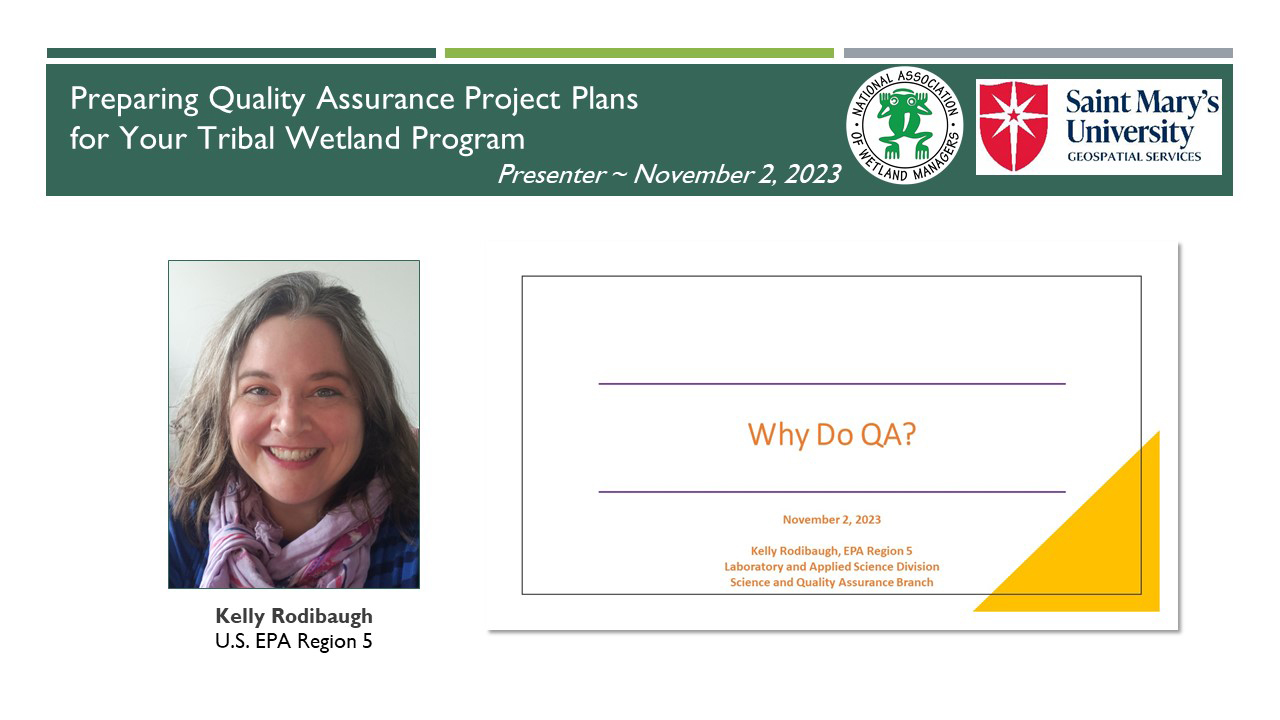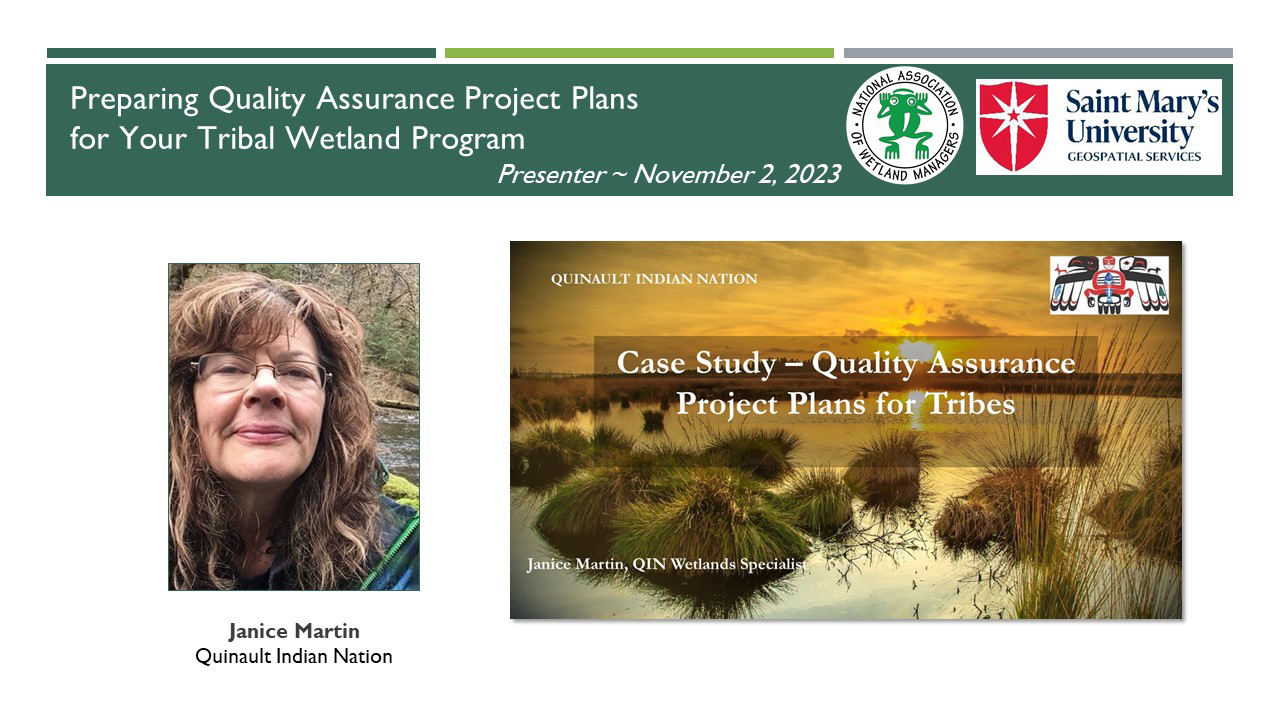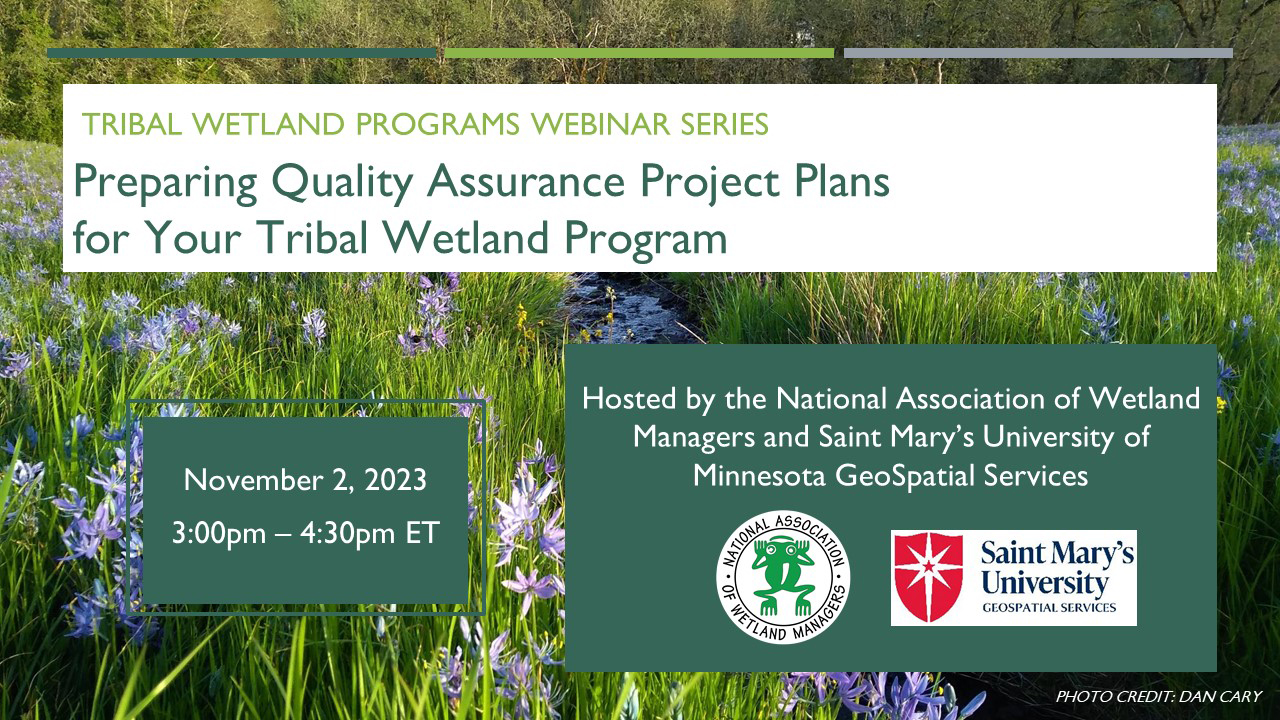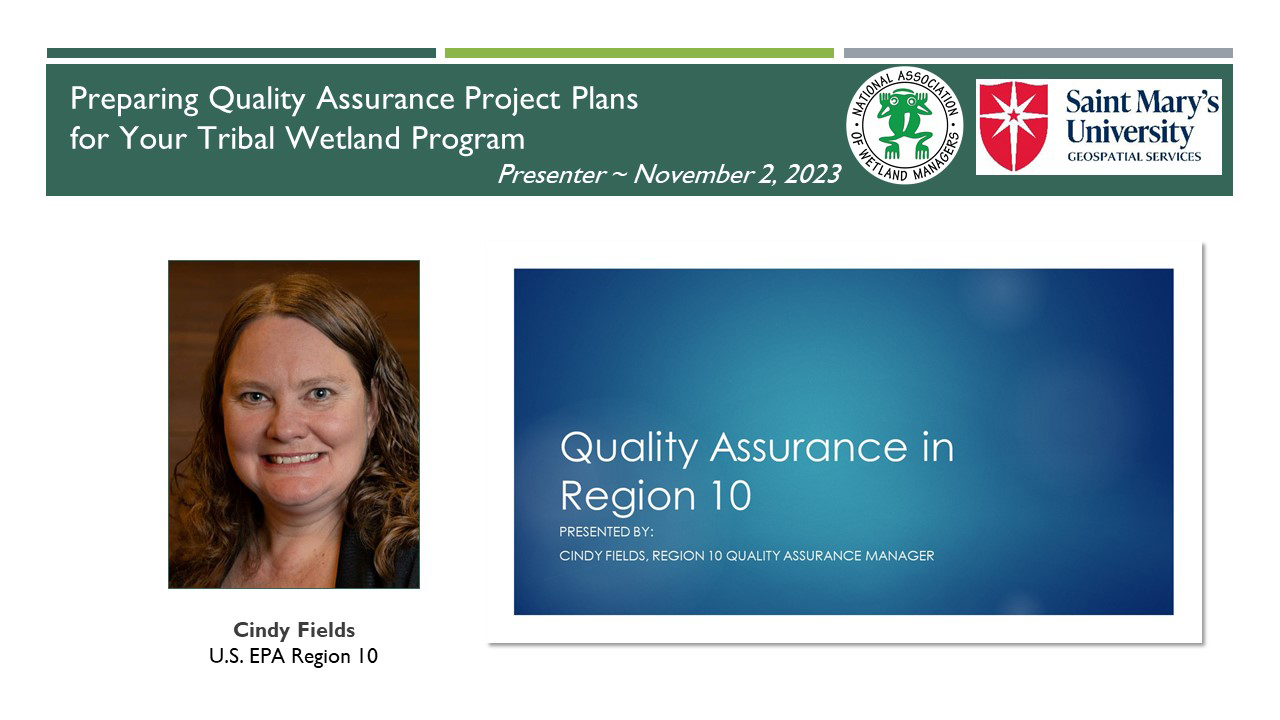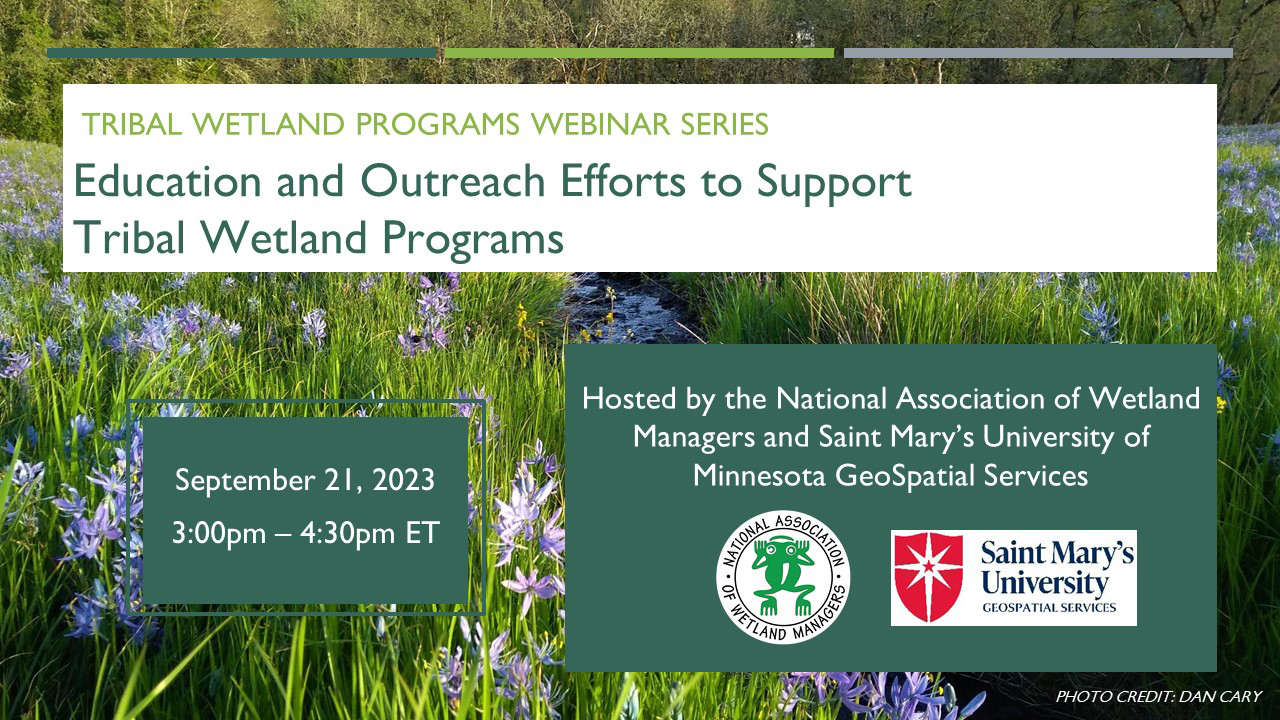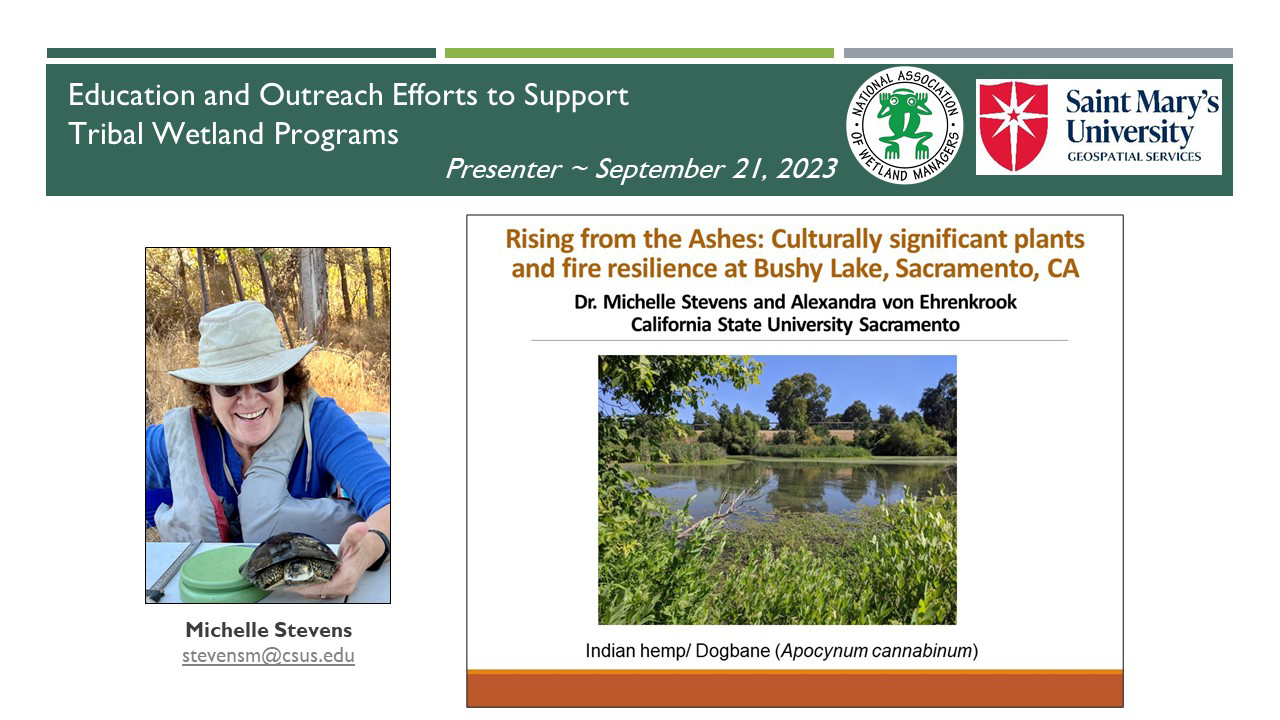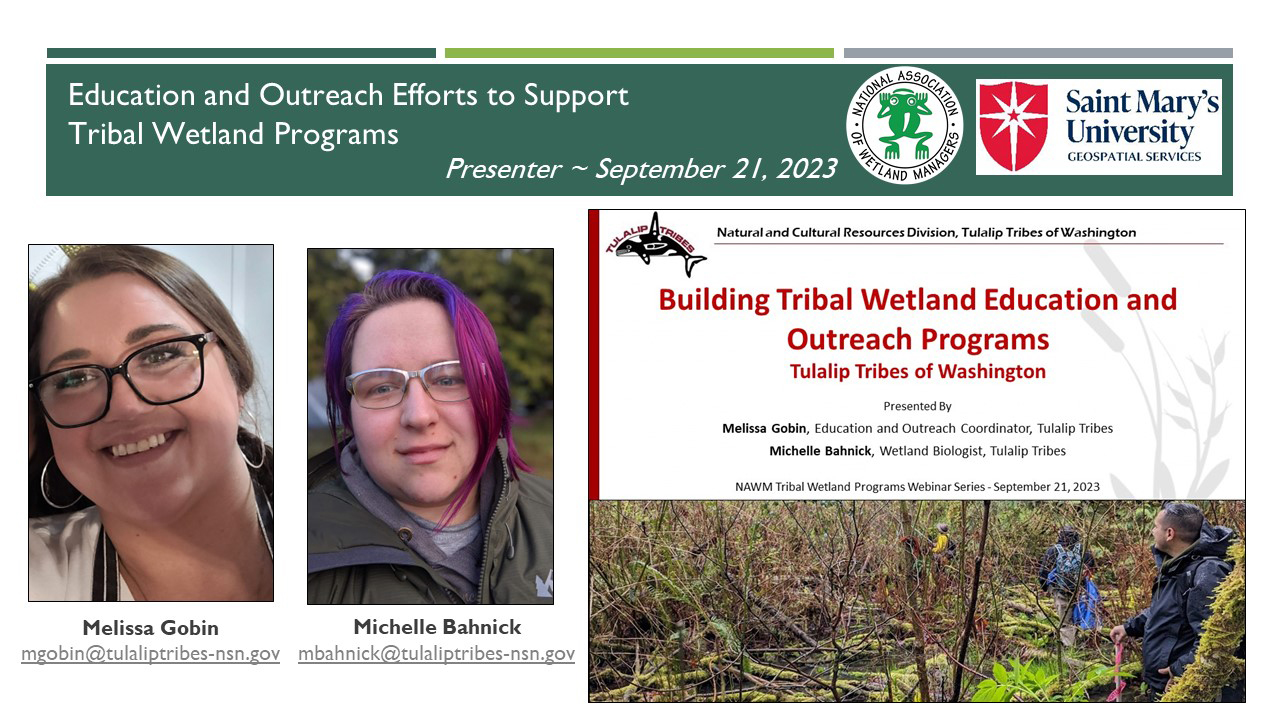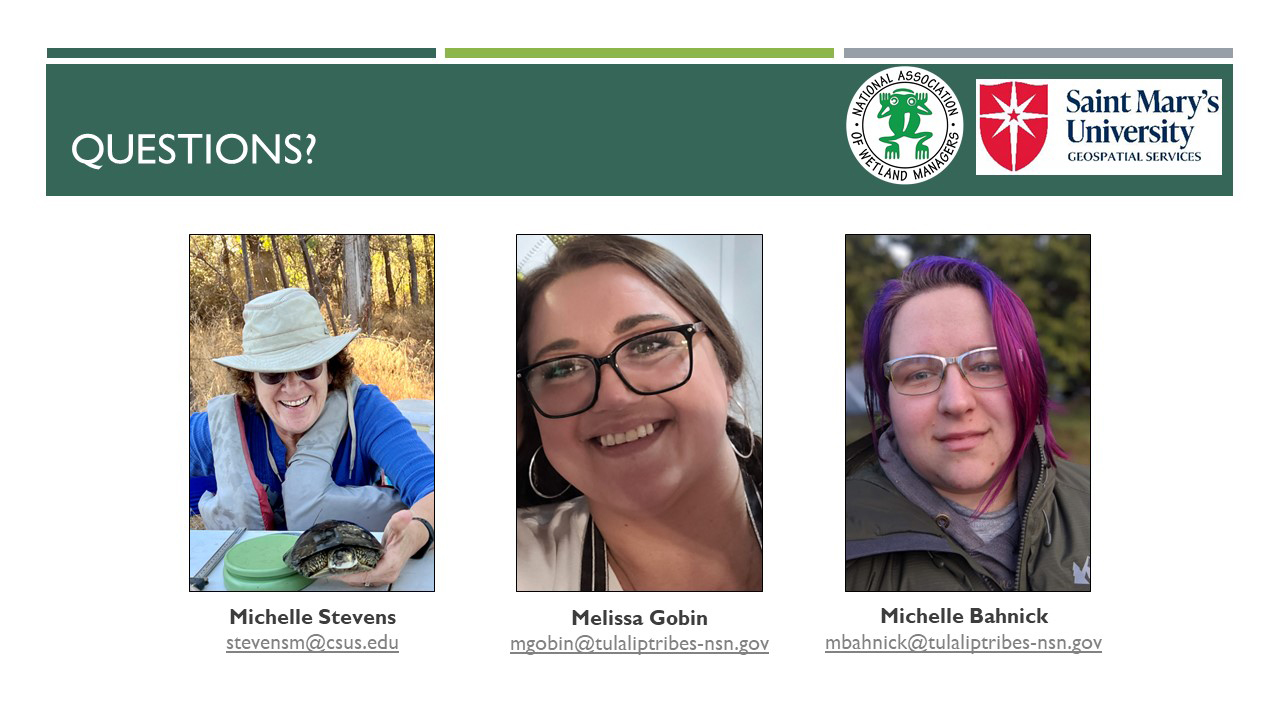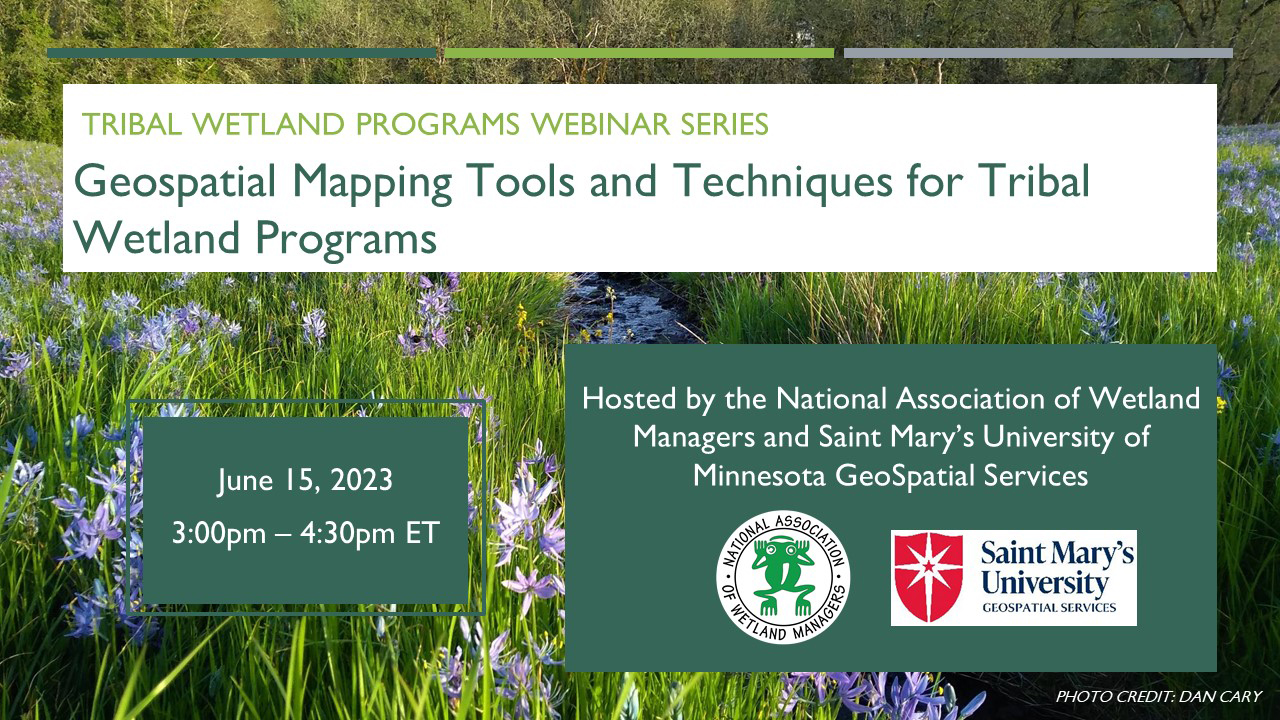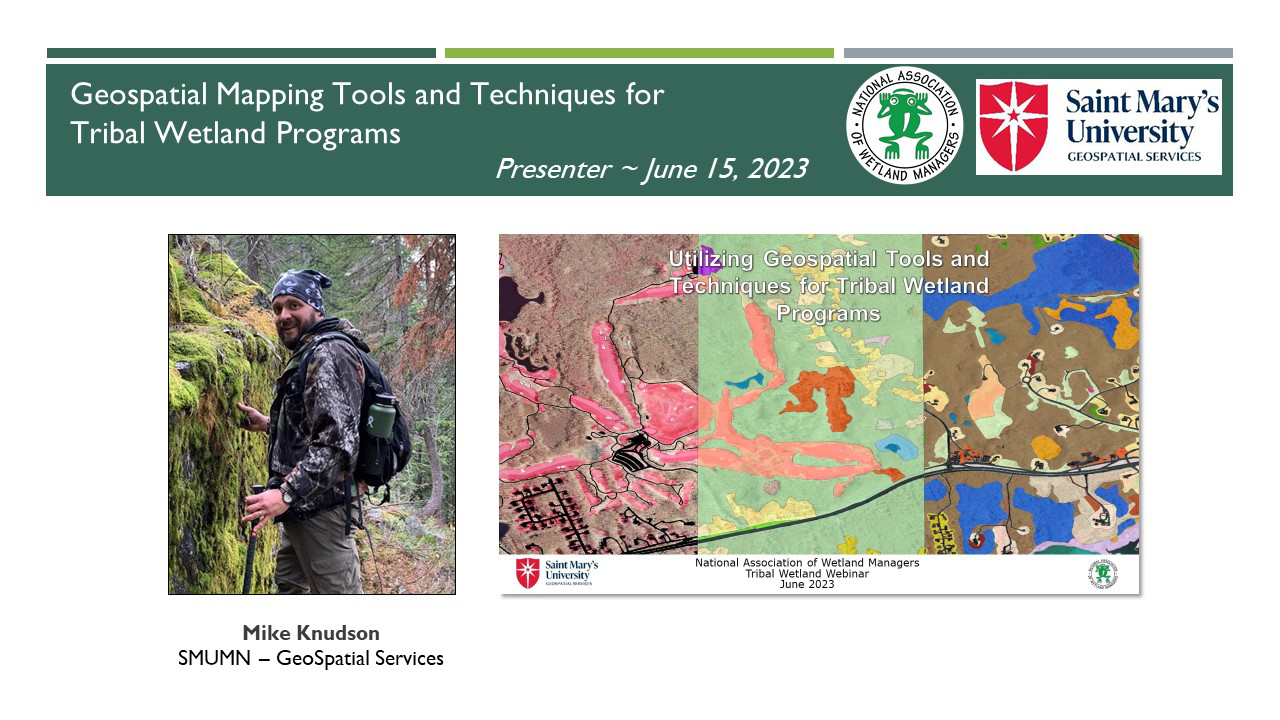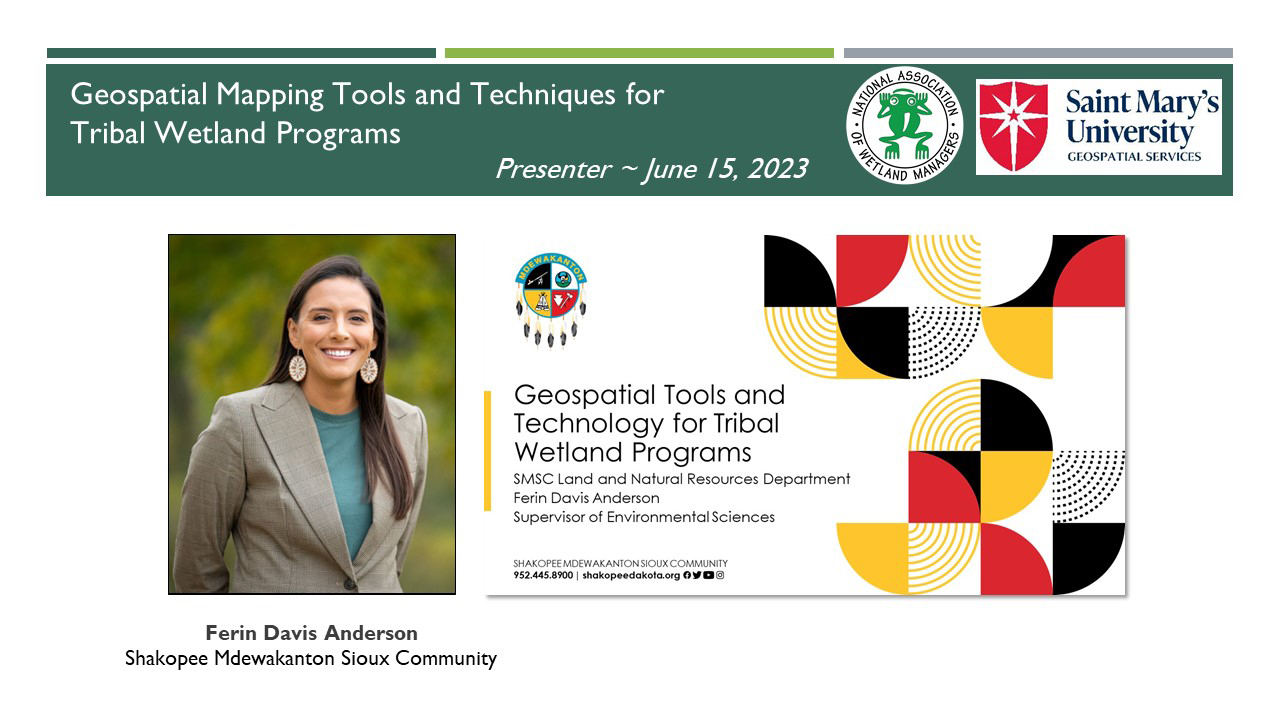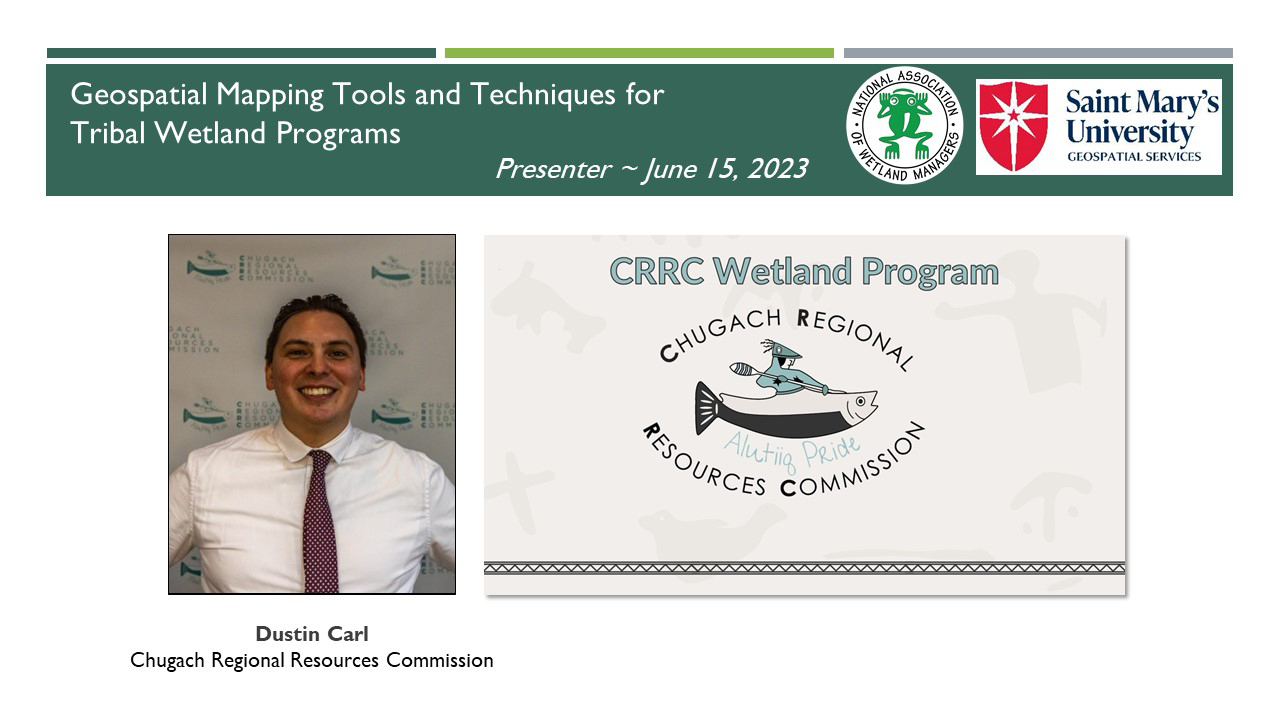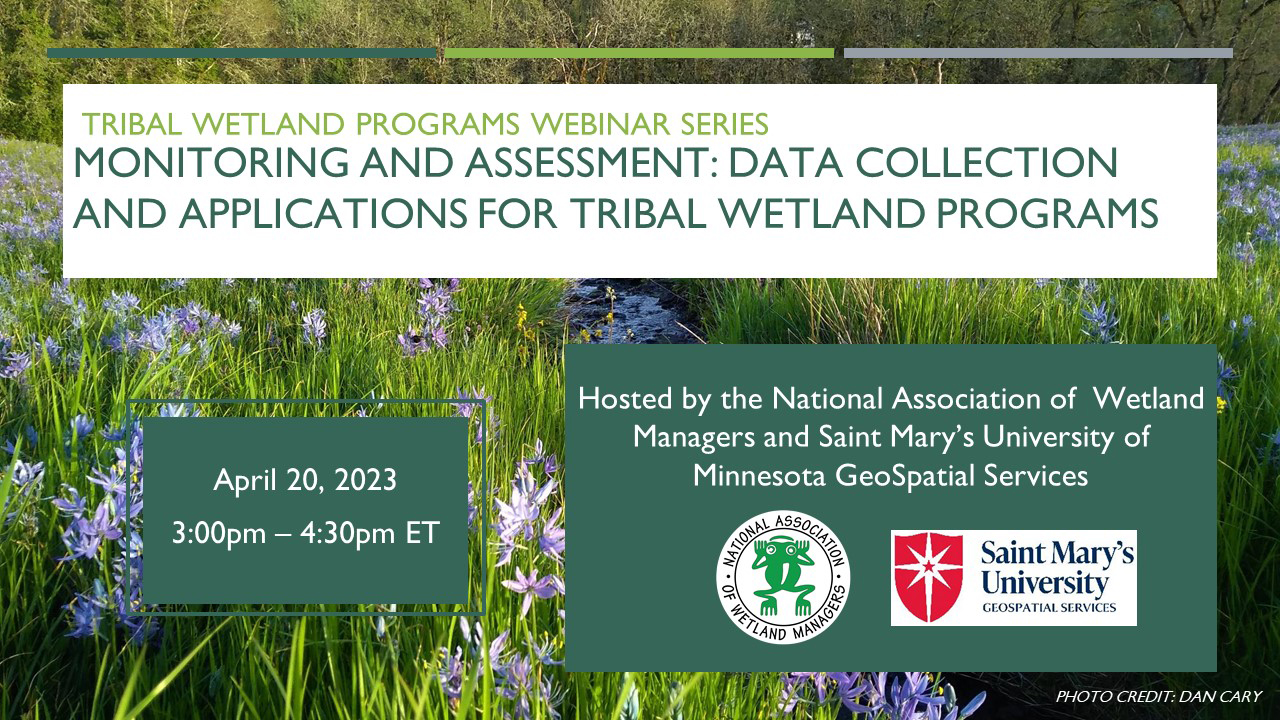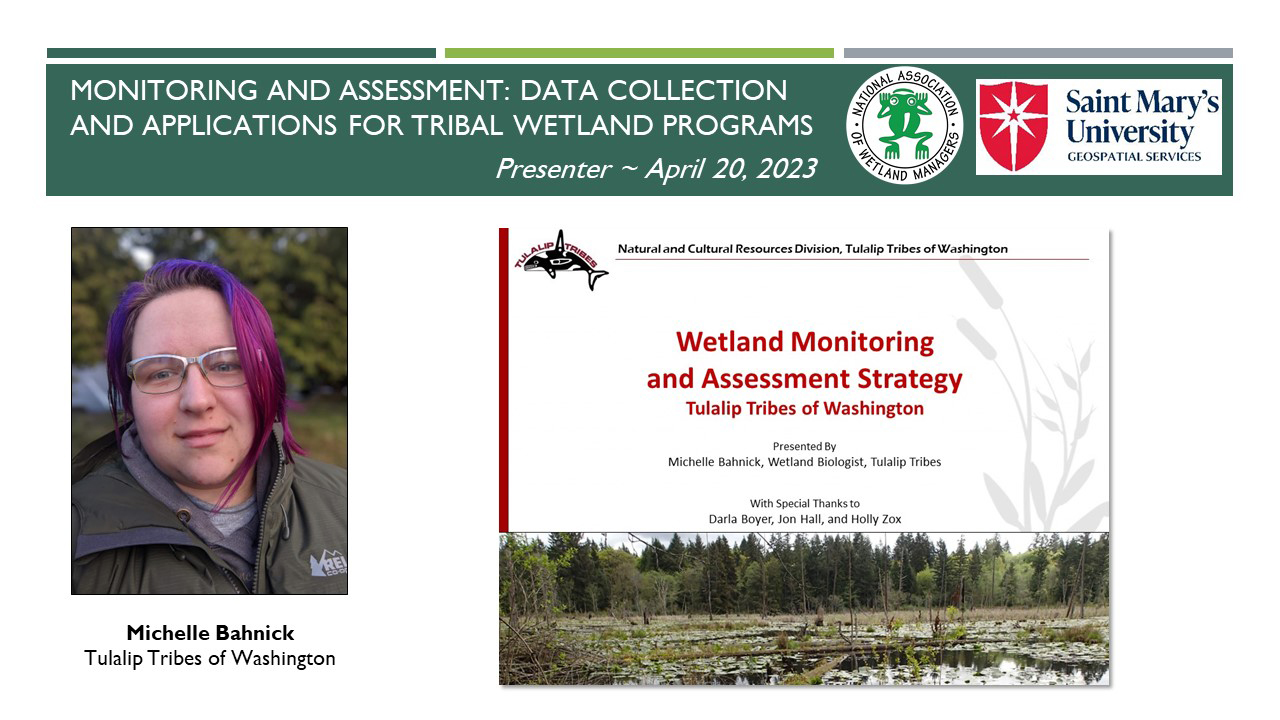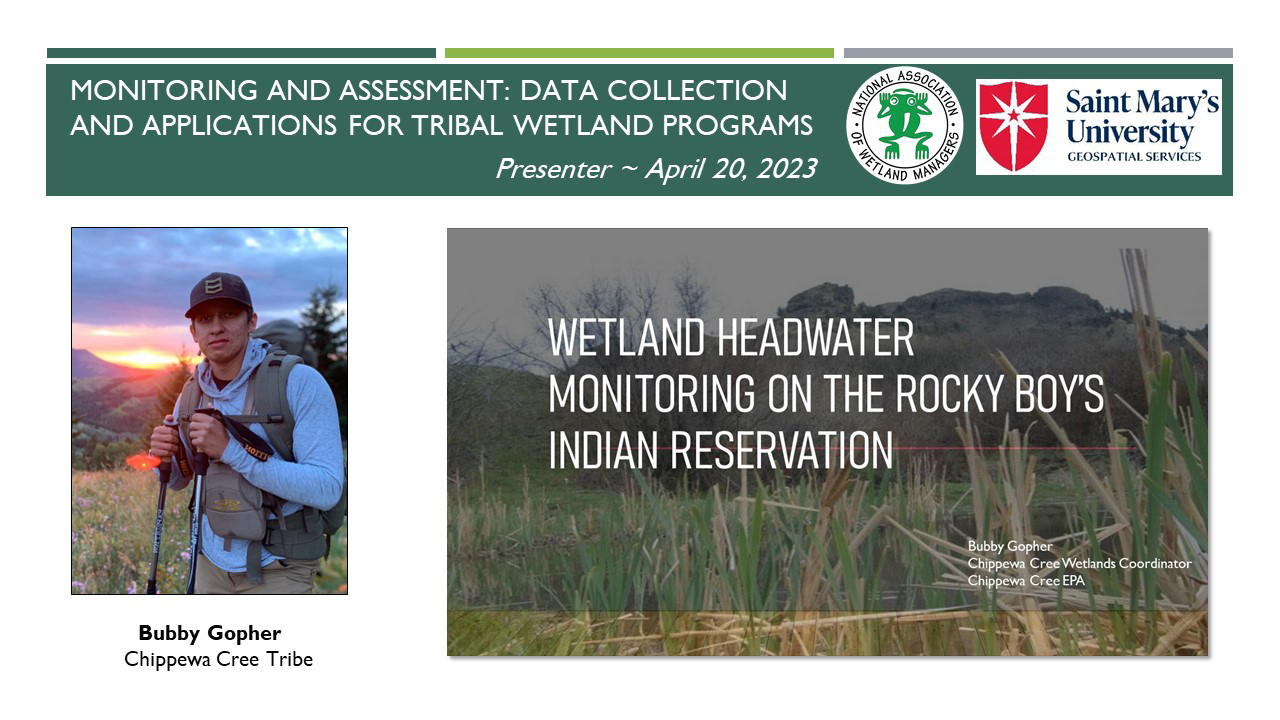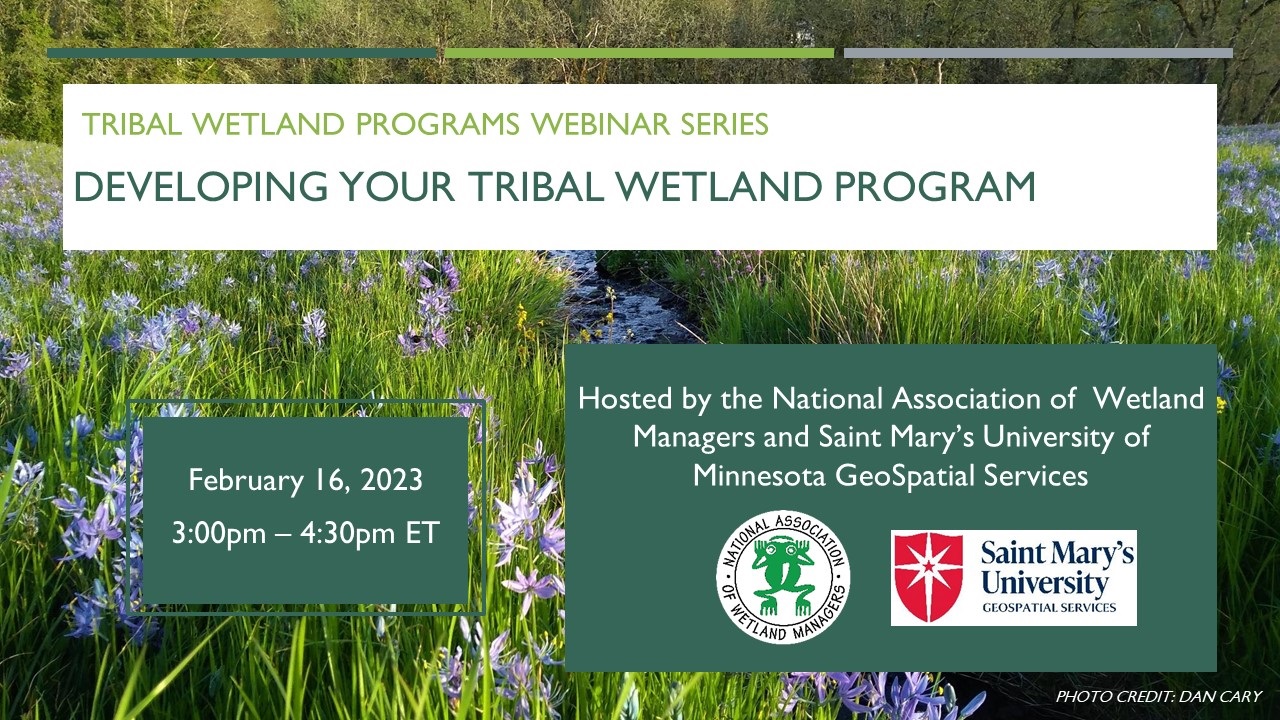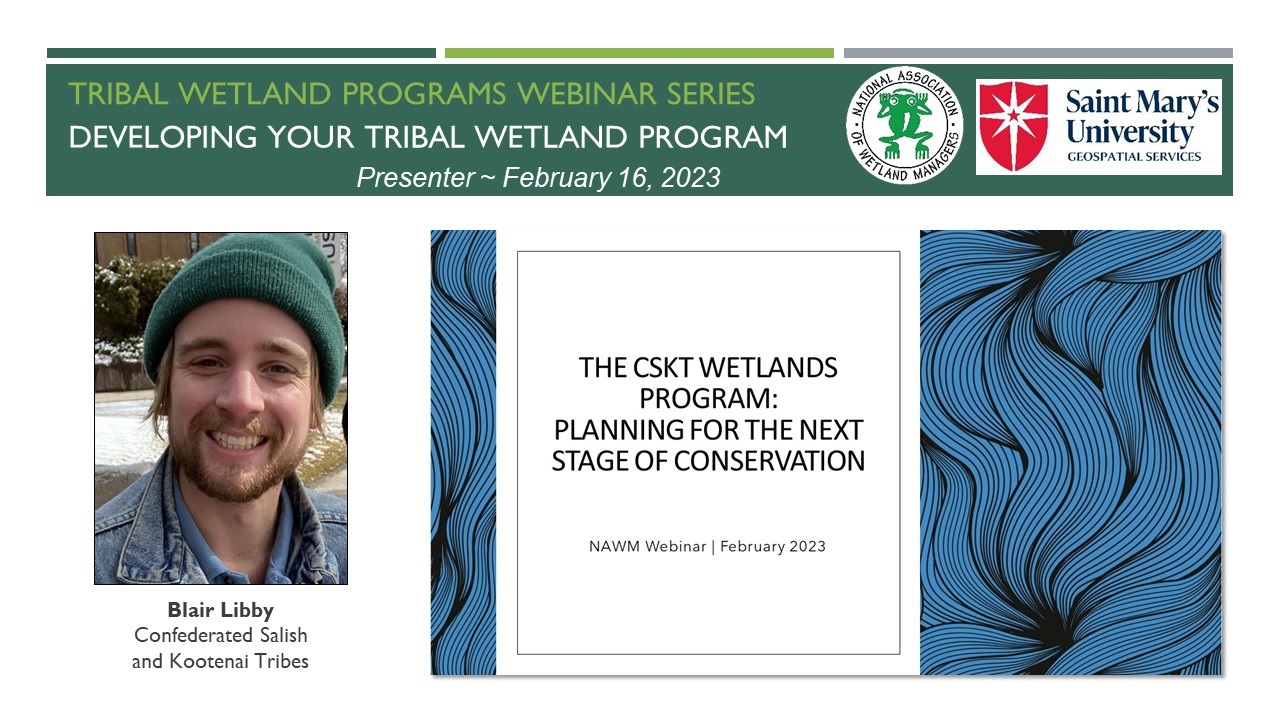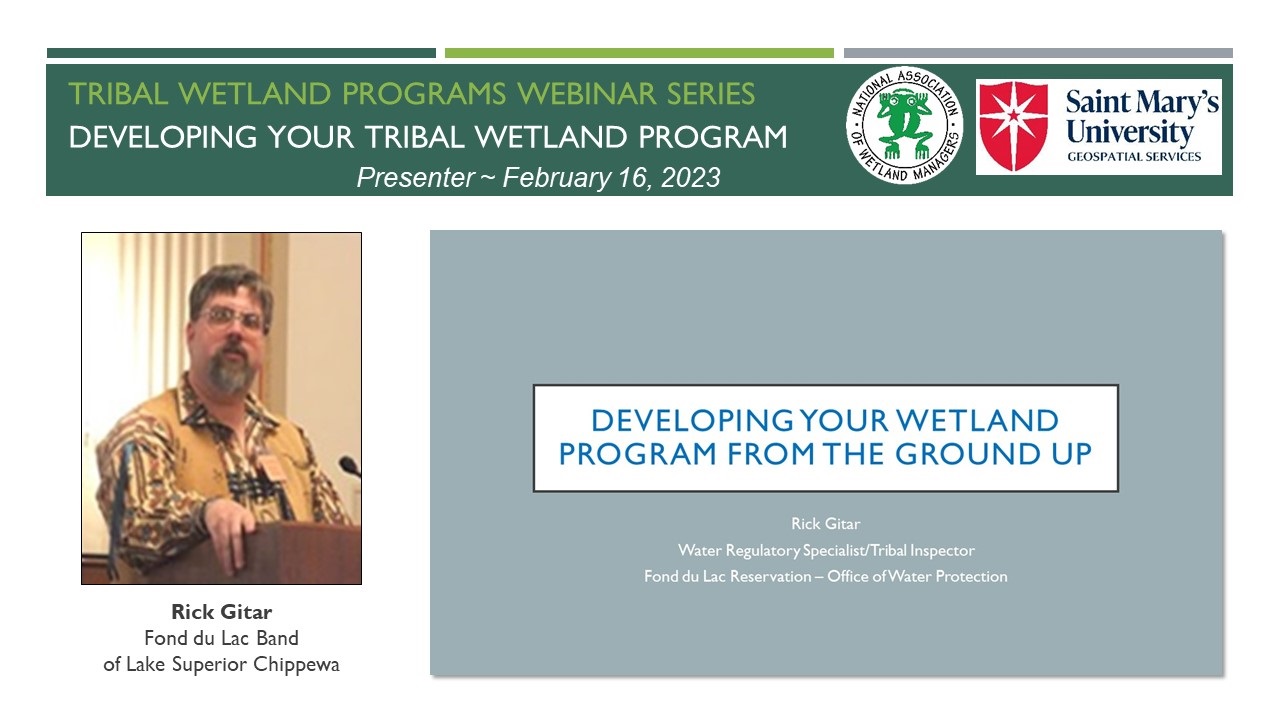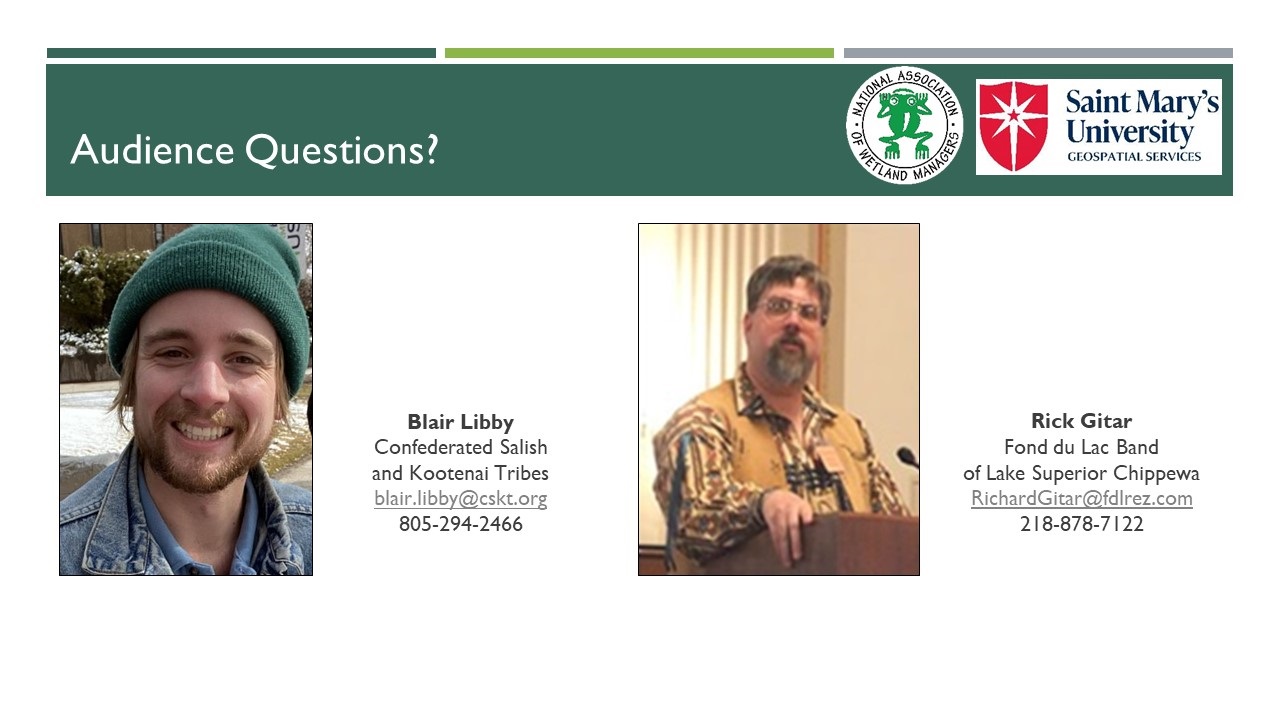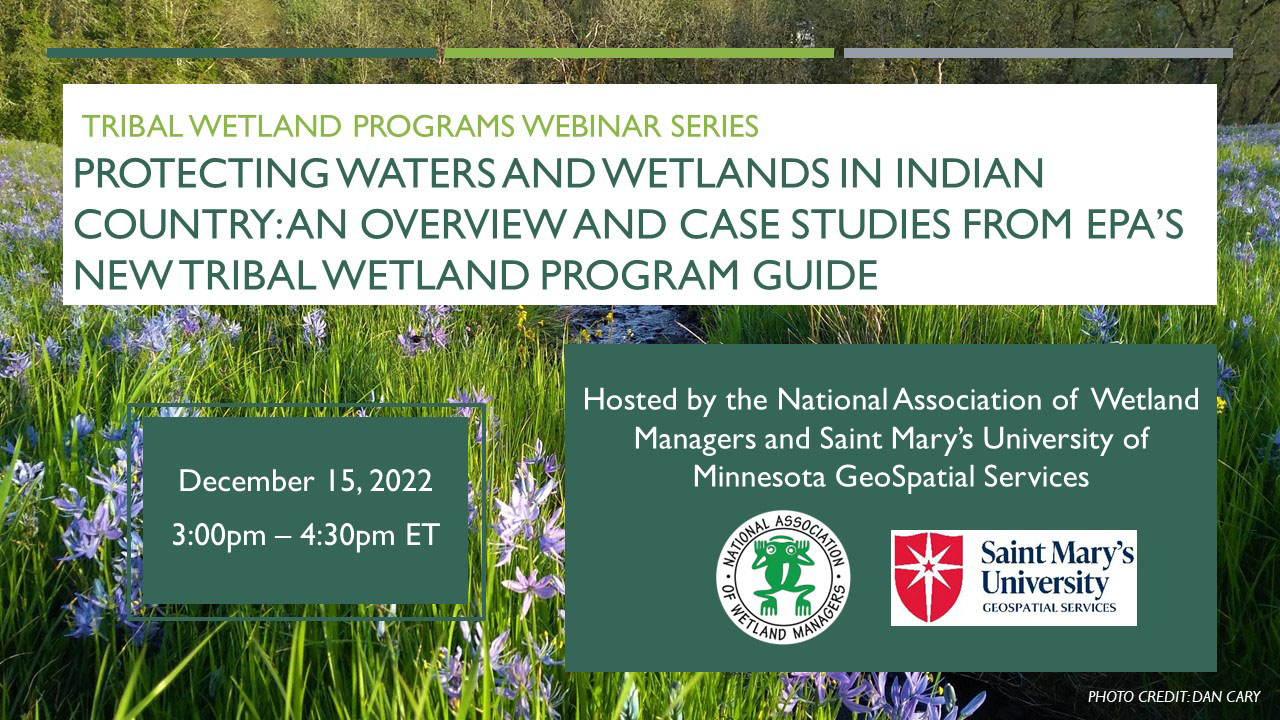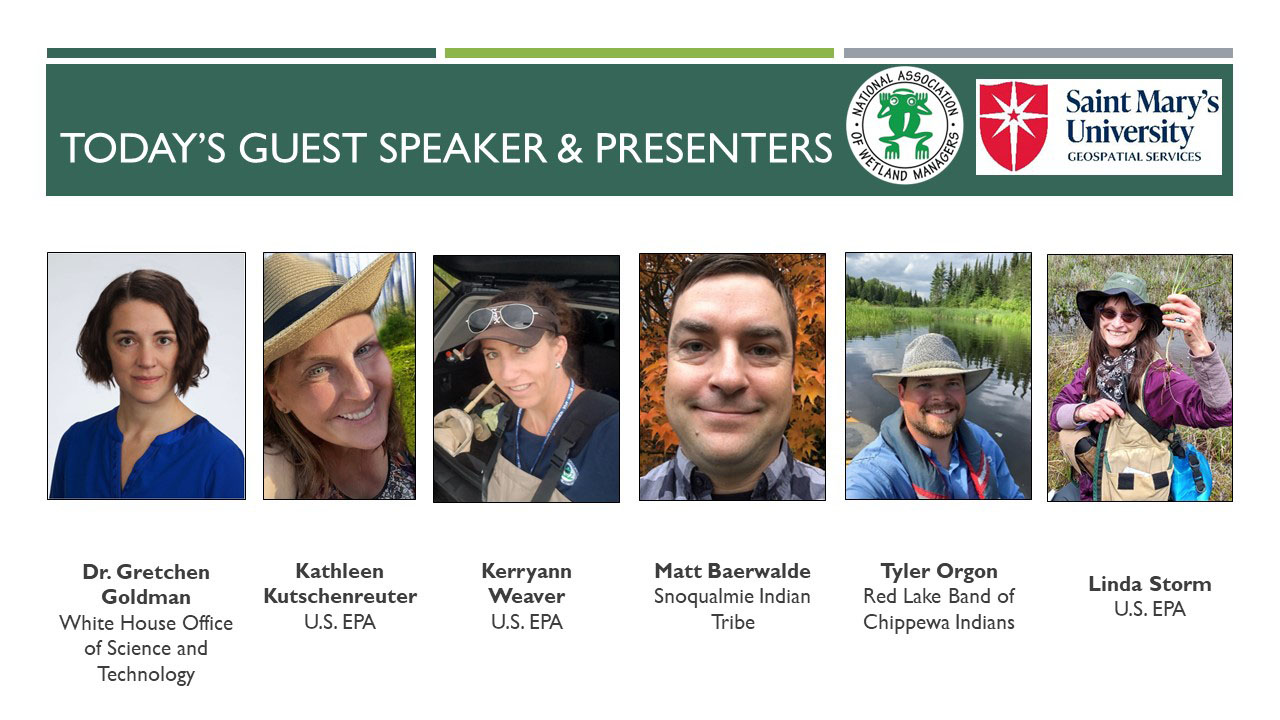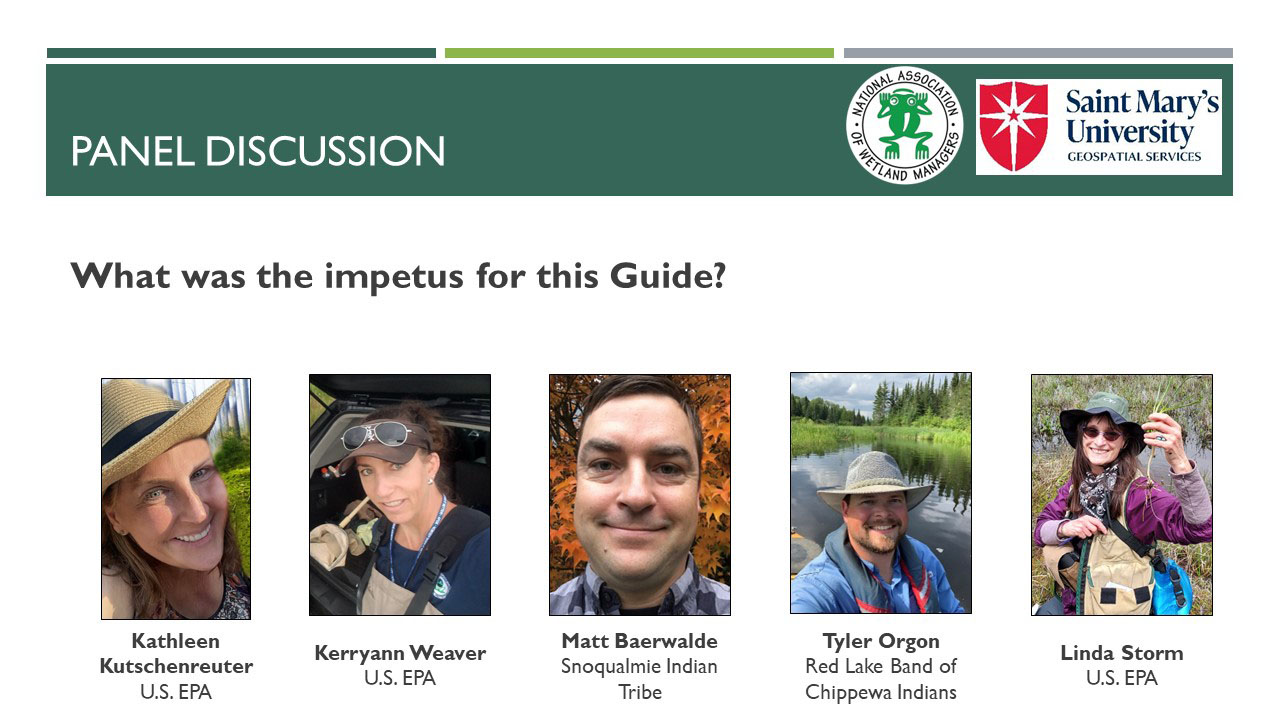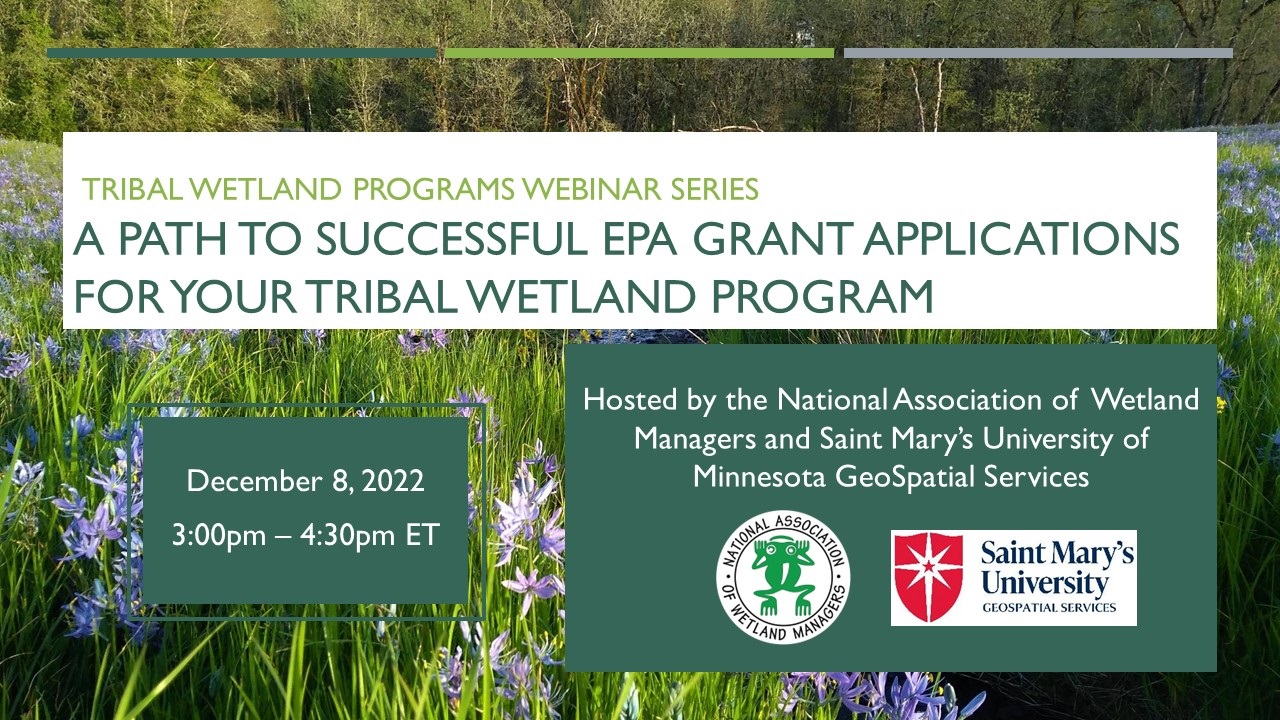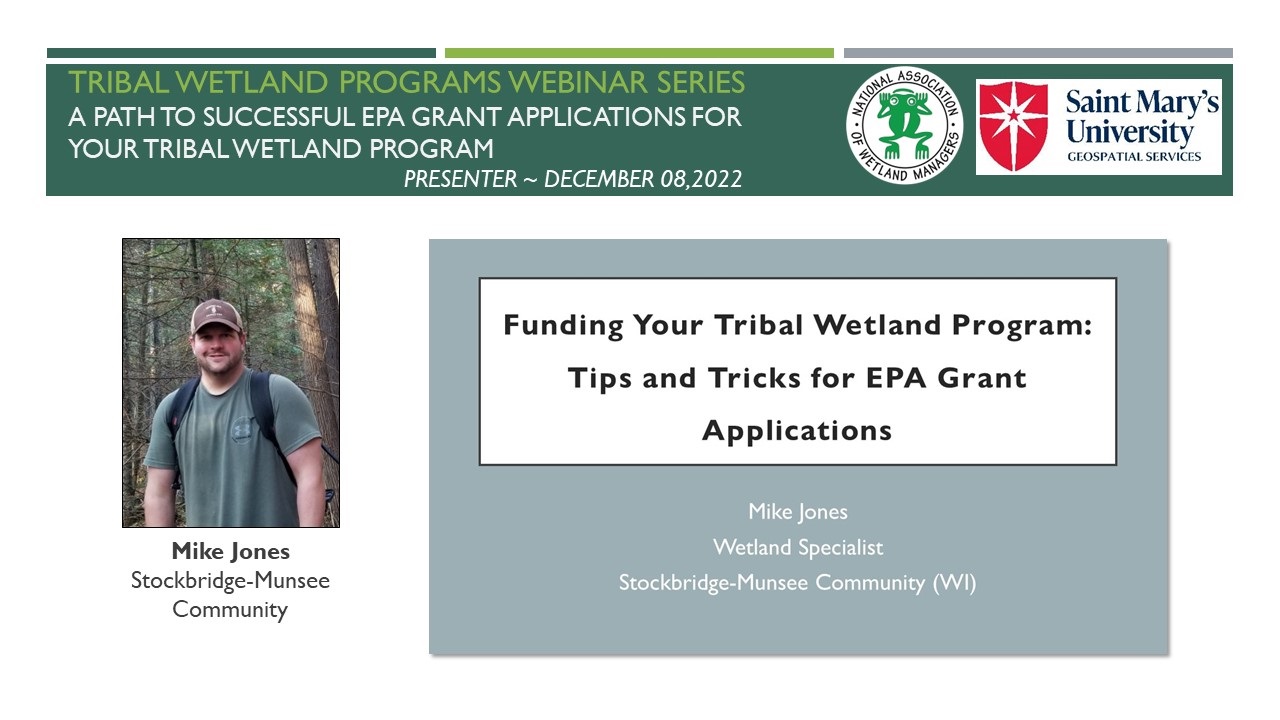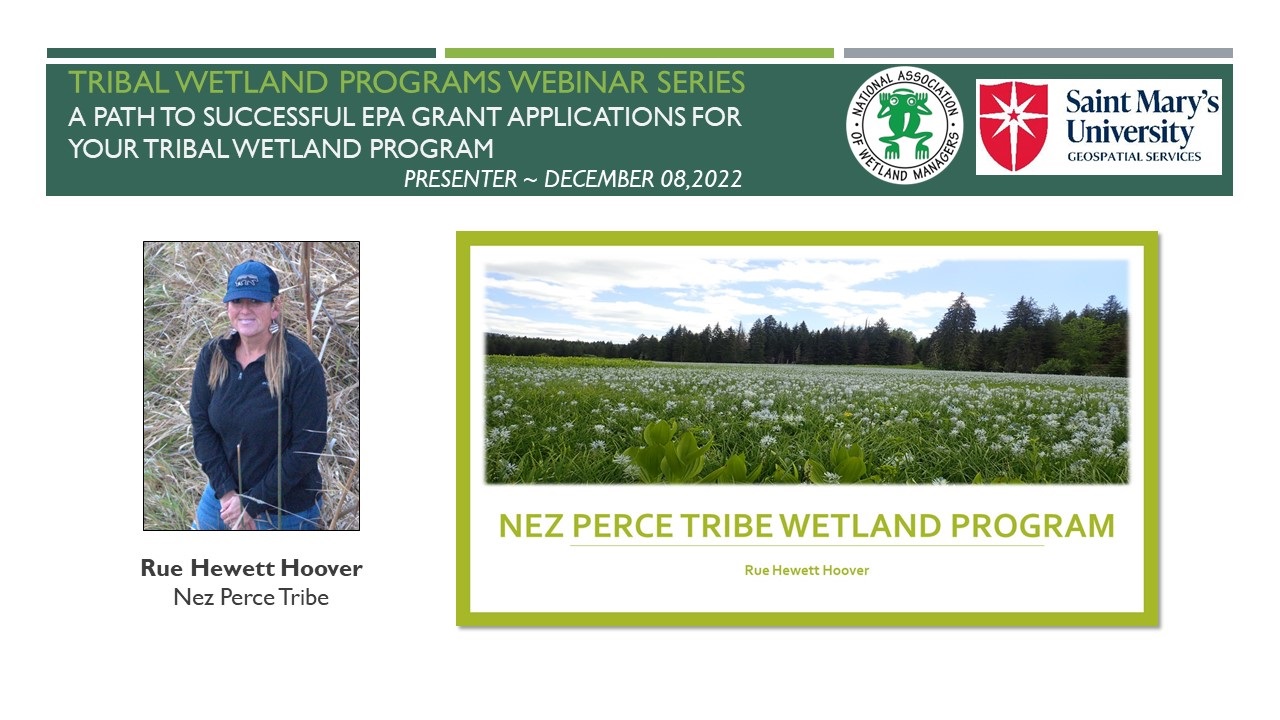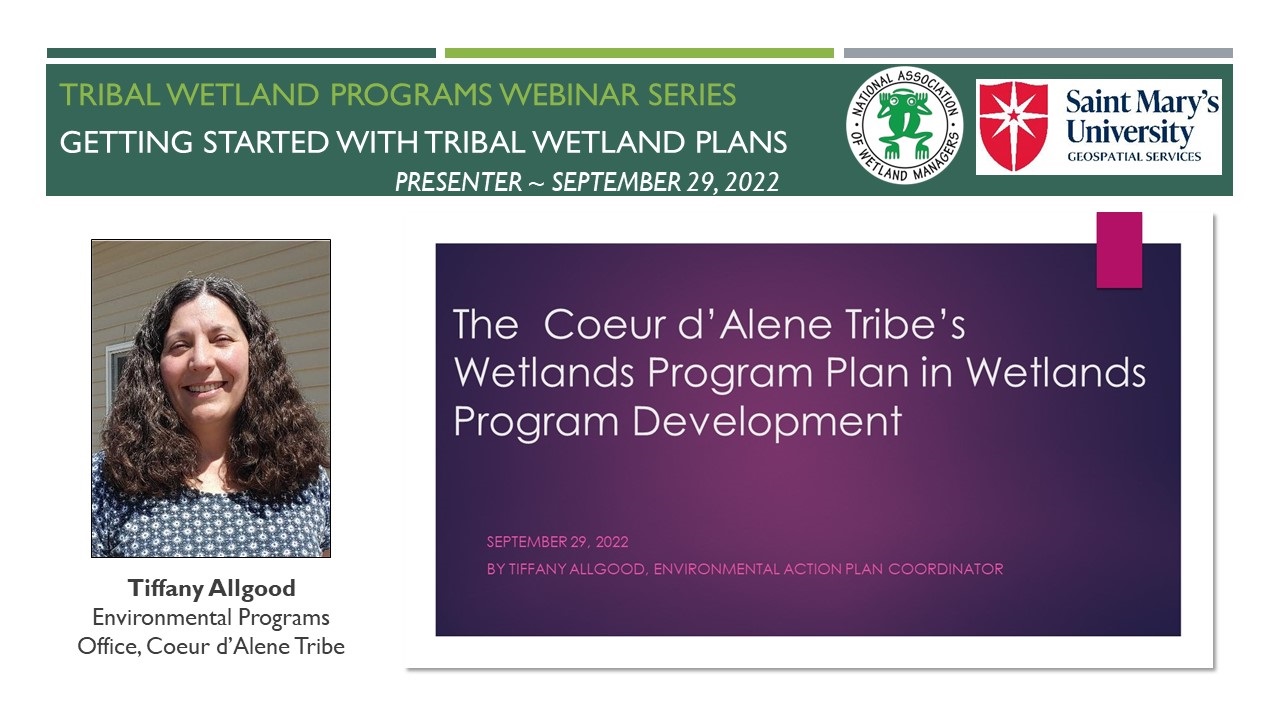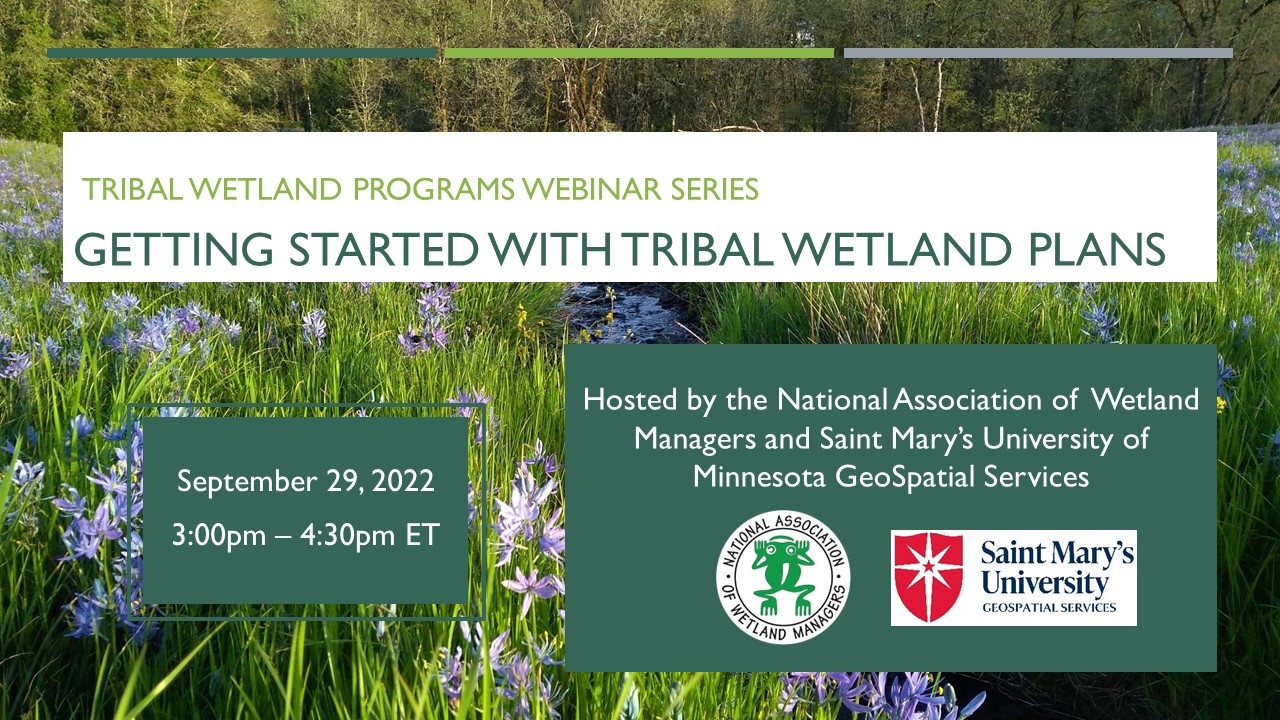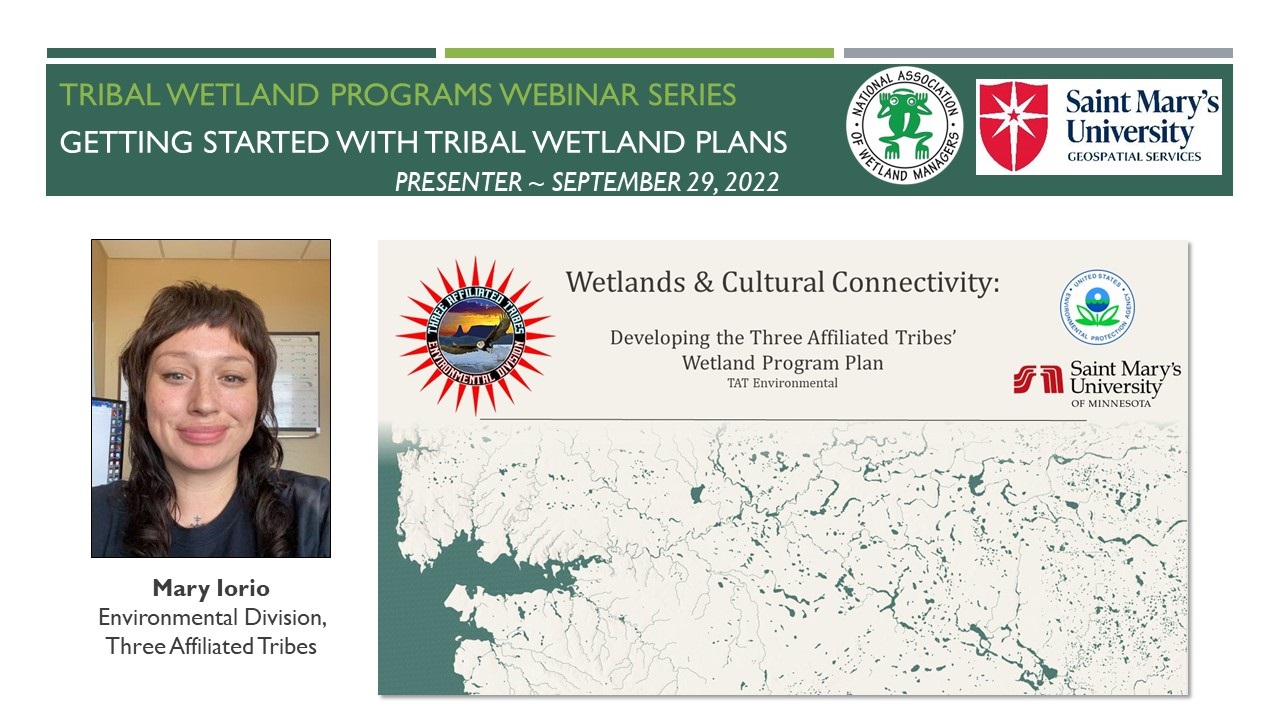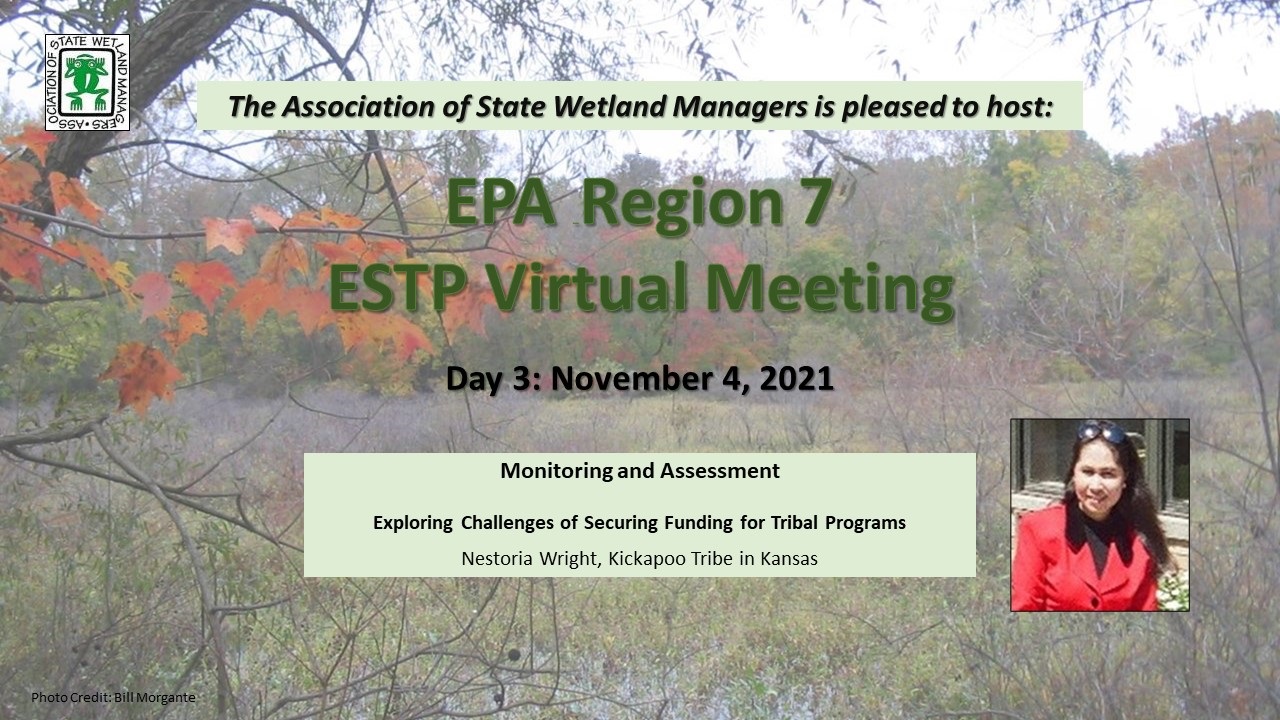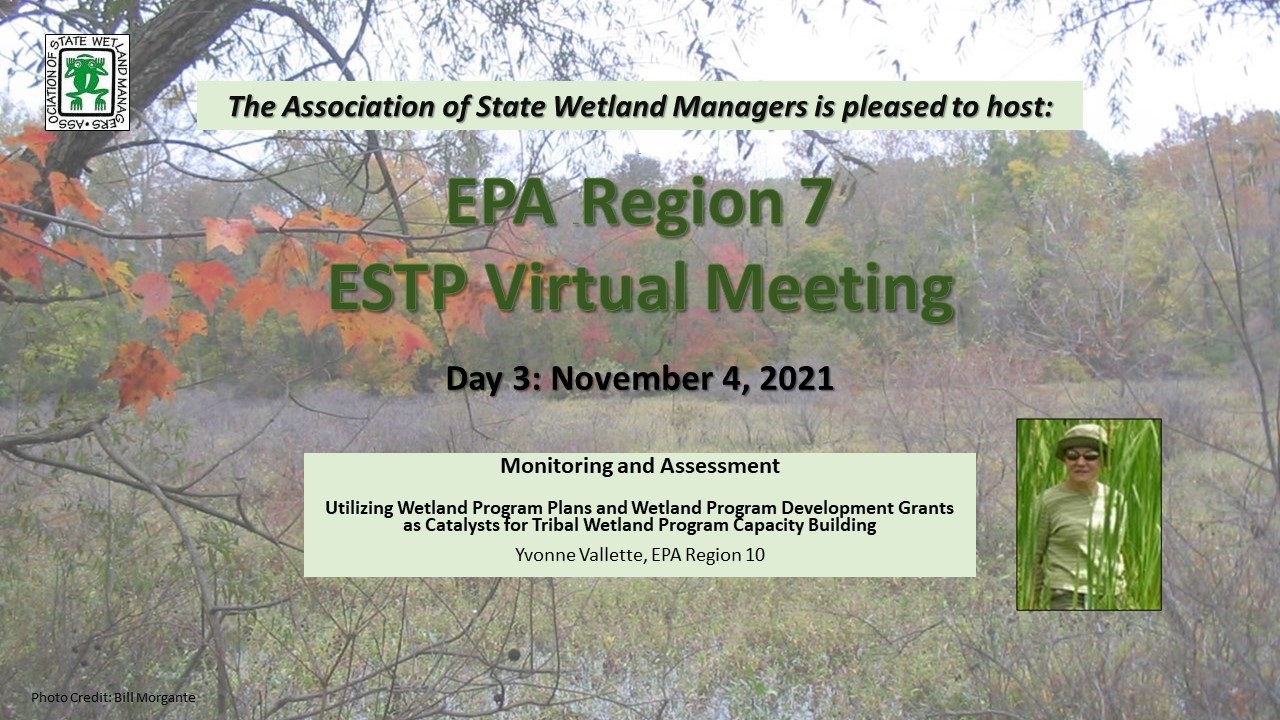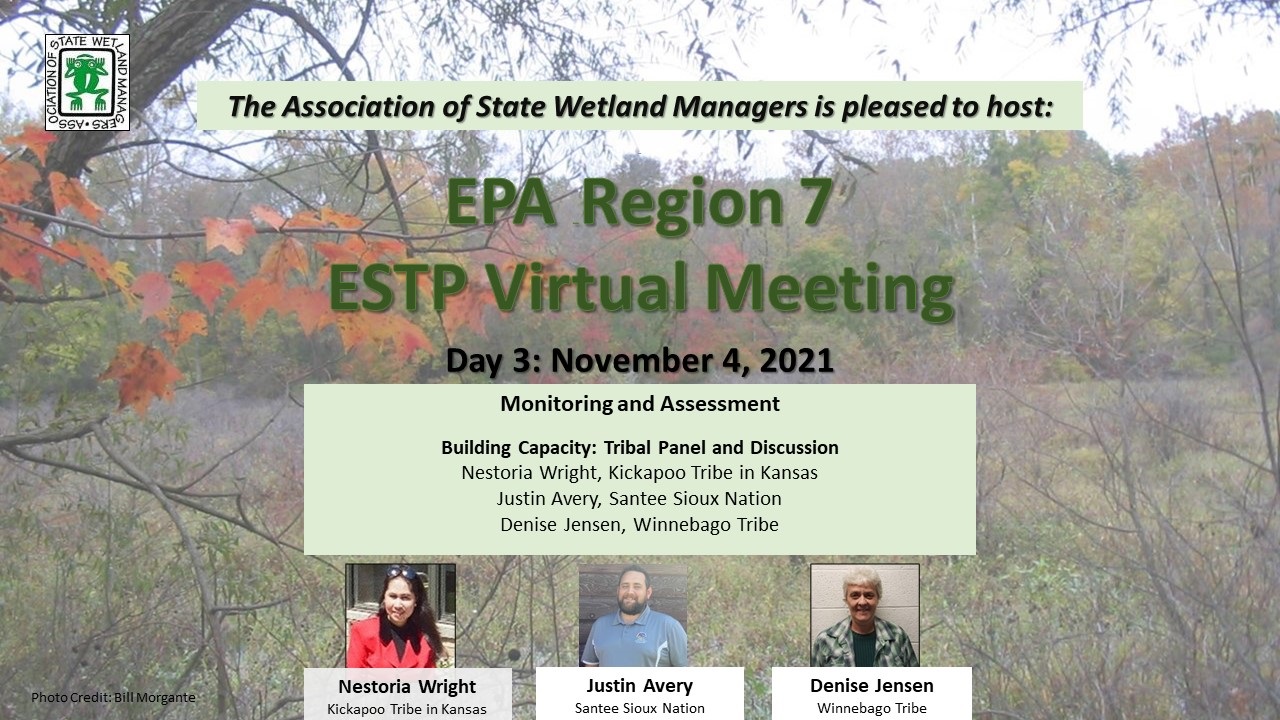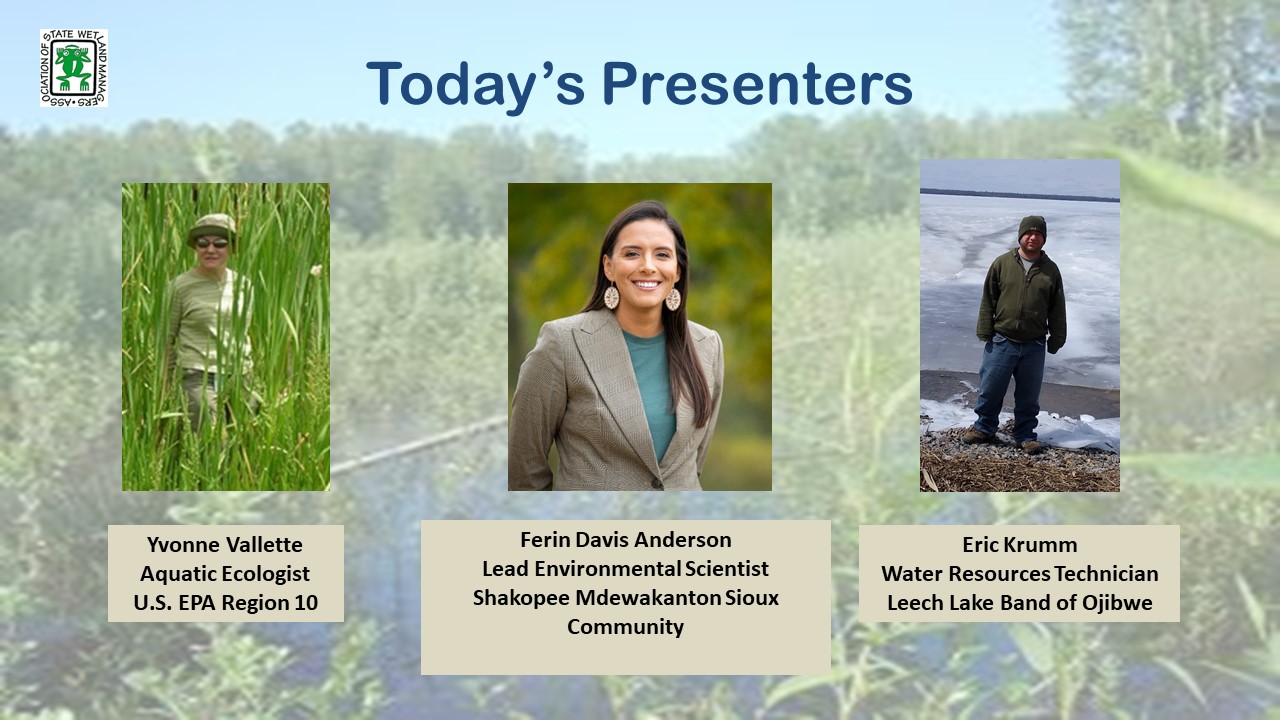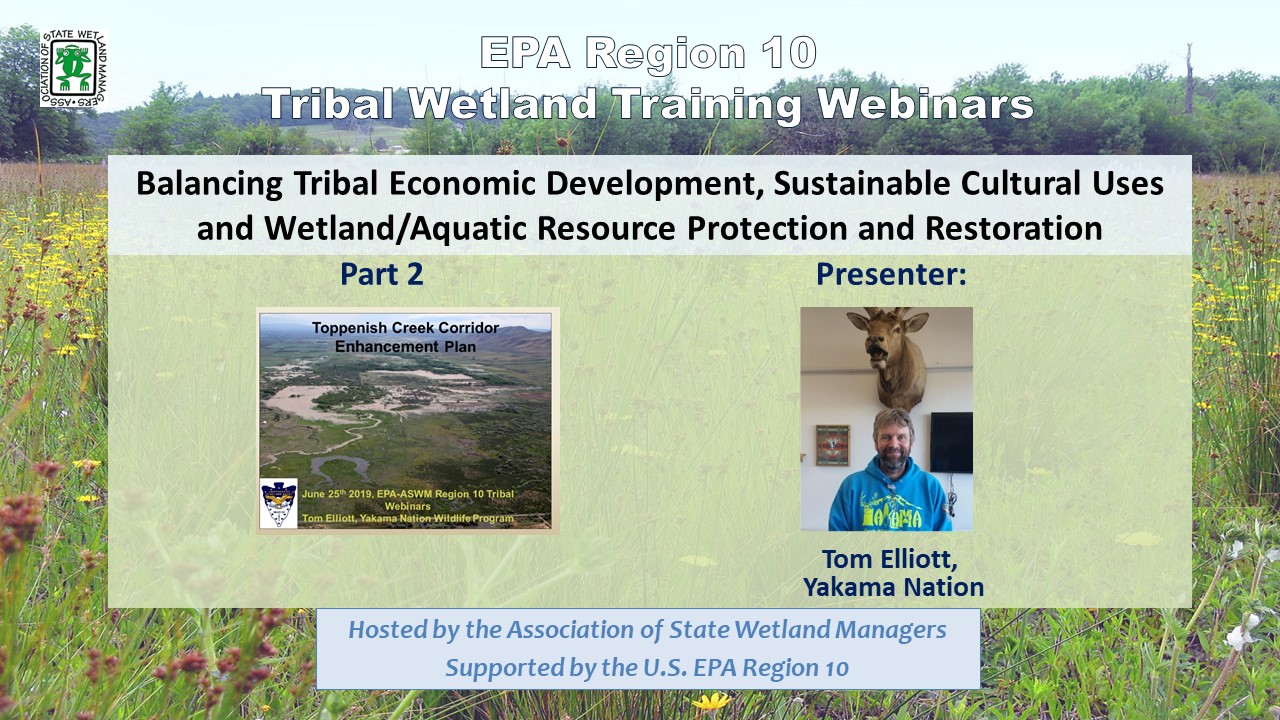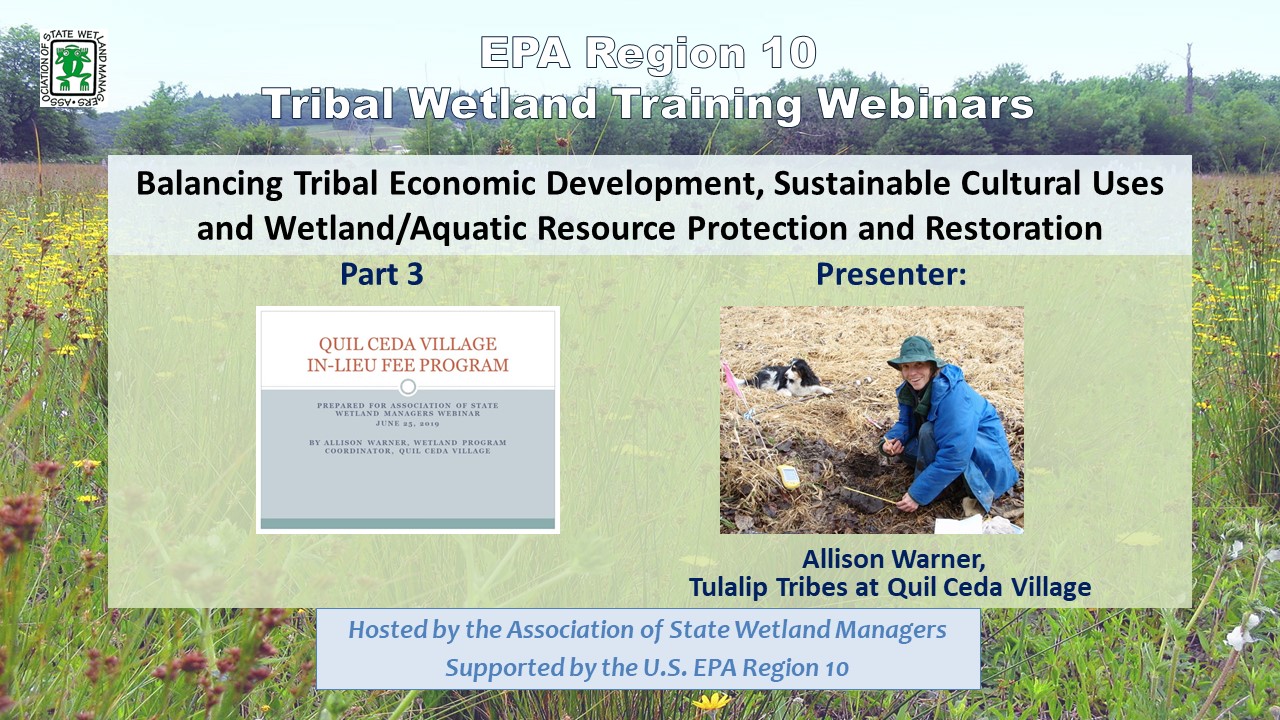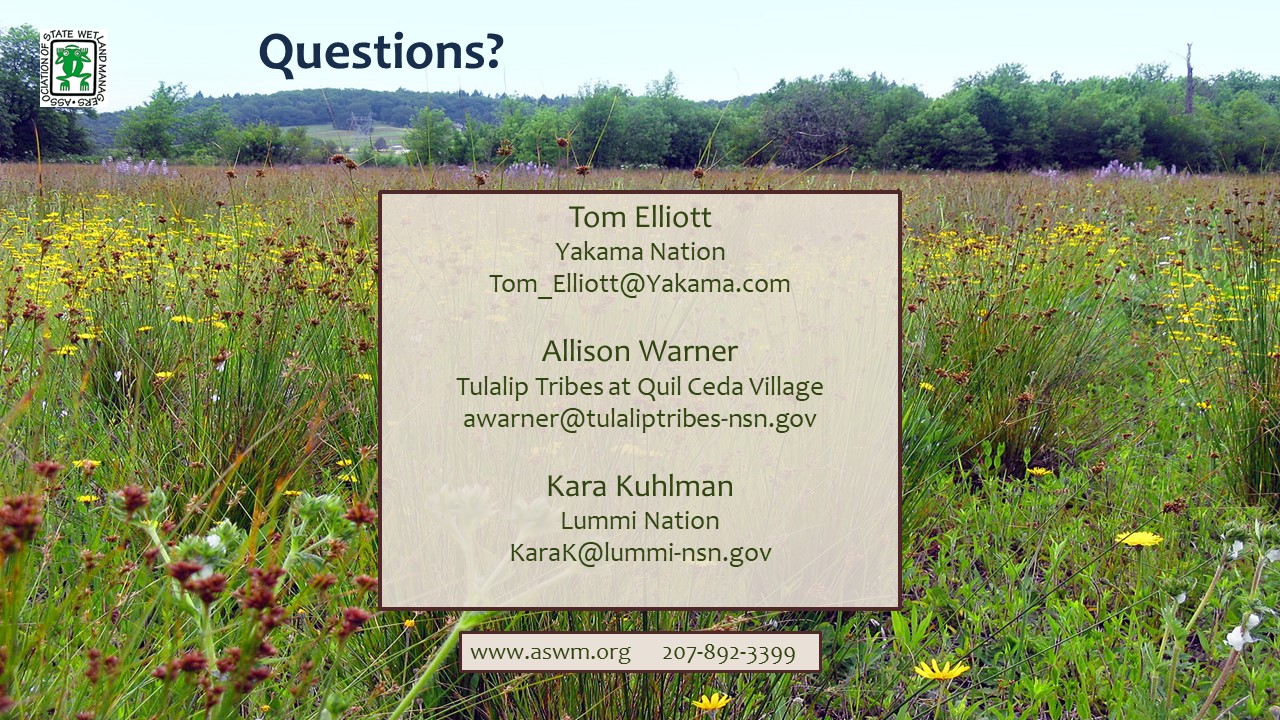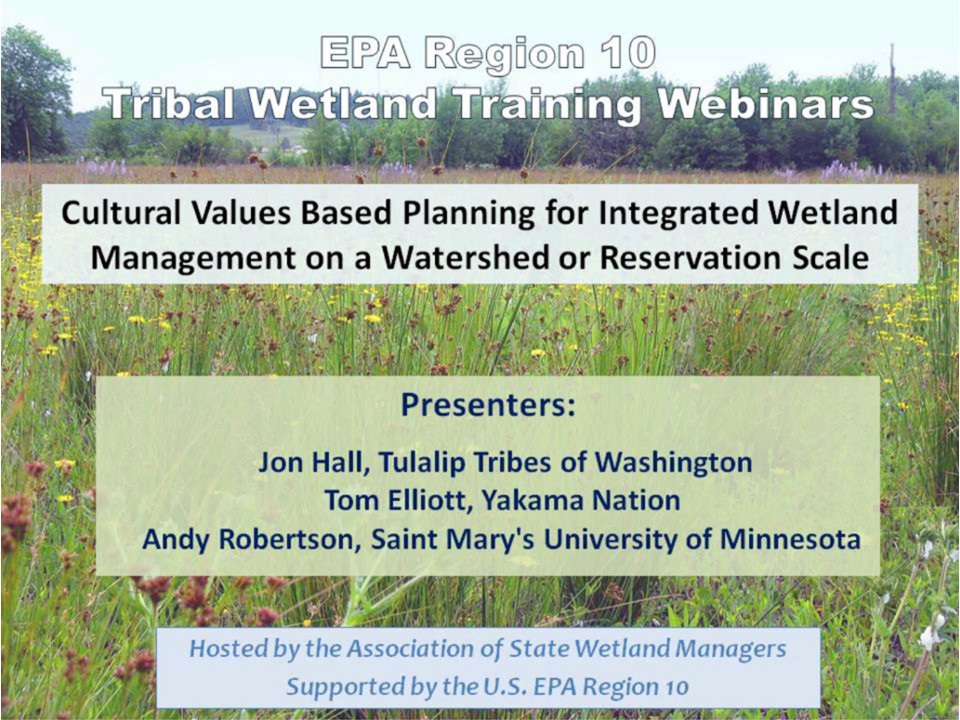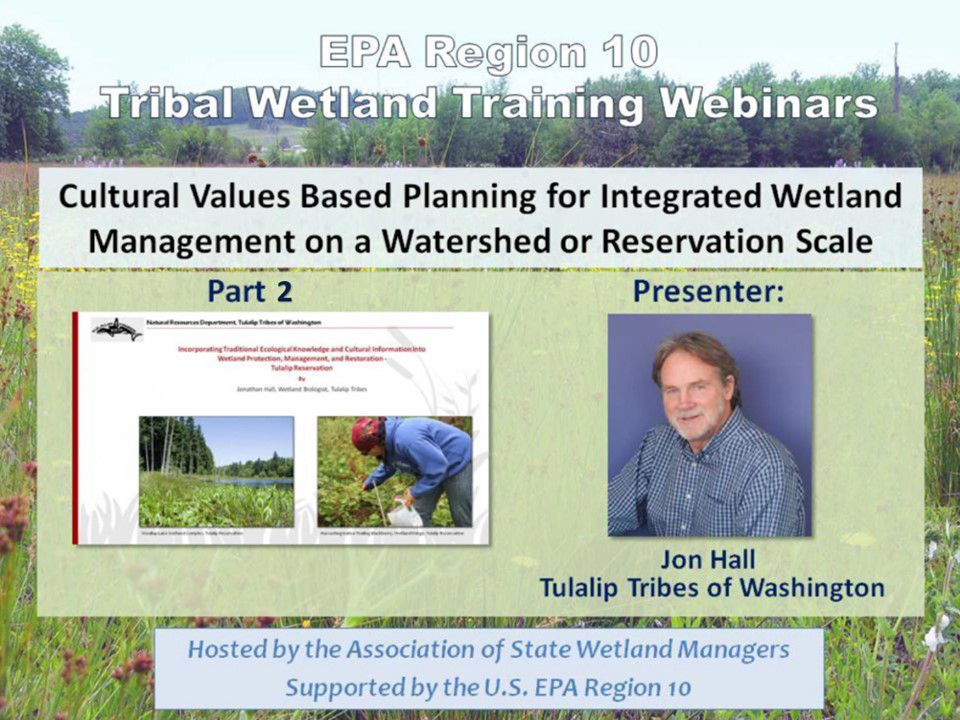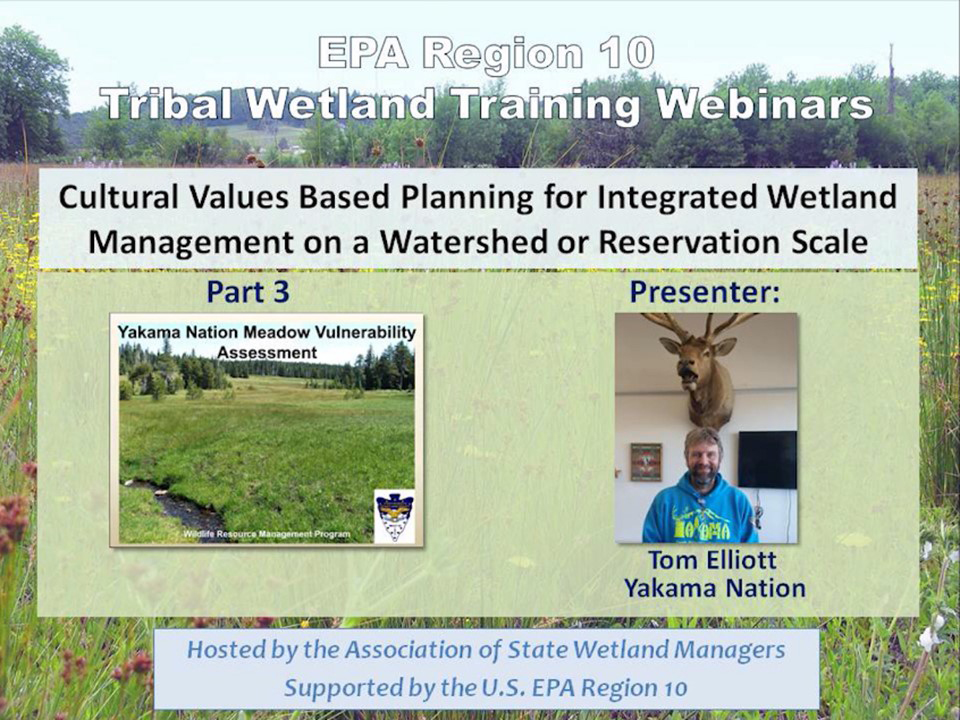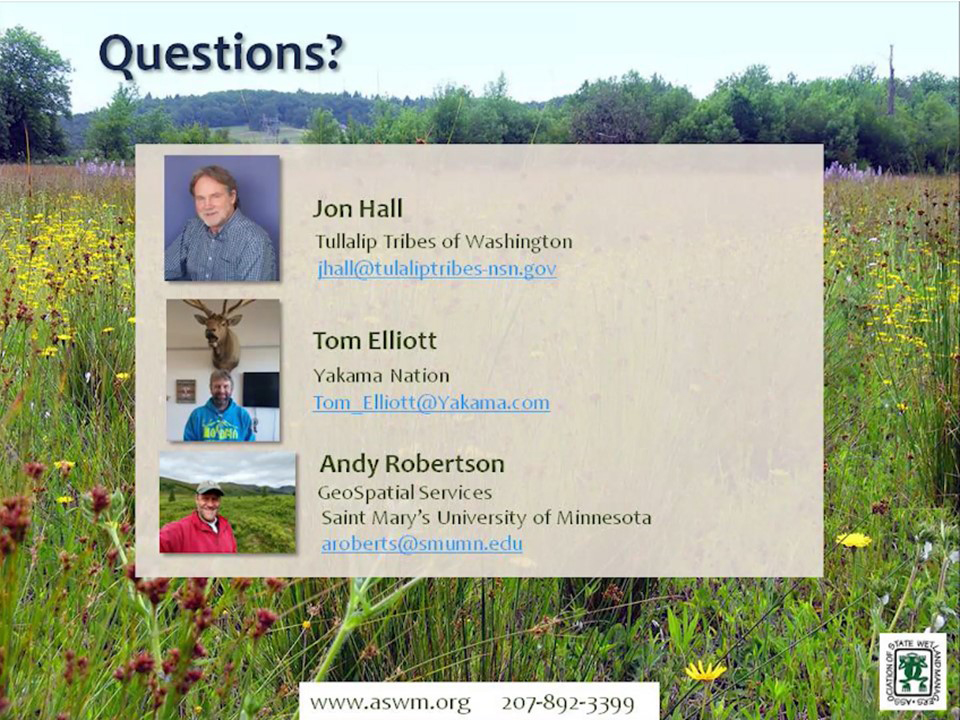Preparing Quality Assurance Project Plans for Your Tribal Wetland Program
Held Thursday, November 2, 2023 - 3:00 p.m.-4:30 p.m. Eastern
INTRODUCTION
- Portia Osborne, Project Manager, National Association of Wetland Managers [PRESENTATION PDF]
PRESENTERS
- Kelly Rodibaugh, U.S. Environmental Protection Agency, Region 5 [PRESENTATION PDF]
- Janice Martin, Quinault Indian Nation Division of Natural Resources [PRESENTATION PDF]
- Cindy Fields, U.S. Environmental Protection Agency, Region 10 [PRESENTATION PDF]
ABSTRACT
Many of the activities undertaken by tribal wetland programs require the preparation and approval of a Quality Assurance Project Plan (QAPP). A QAPP is a project-specific plan that lays out the type and quality of environmental data to be collected, including the quality assurance and quality control measures that will be used to ensure data quality. EPA must approve of a QAPP before the project can begin. This webinar will provide a general introduction to QAPP requirements and EPA’s review and approval process for these documents. In addition, an example of recent experience developing a project-specific QAPP for a tribal wetland program will be shared. Throughout the webinar, presenters shared recommendations for QAPP preparation and insights specific to tribal wetland programs.
Please click only once on each video recording to view in this window.
![]()
Education and Outreach Efforts to Support Tribal Wetland Programs
Held Thursday, September 21, 2023 - 3:00 p.m.-4:30 p.m. Eastern
OVERVIEW
Education and outreach activities can be useful tools in conveying the importance of wetlands to the broader community, engaging youth, and building support for wetland protections and wetland programs. These activities can also be opportunities to incorporate cultural knowledge and values into wetland projects or programs. In this webinar, they learned about education and outreach efforts as a part of the Bushy Lake Eco-Cultural Project in Sacramento, CA and within the work conducted by the Tulalip Tribes of Washington Natural and Cultural Resources Division.
INTRODUCTION
- Portia Osborne, Project Manager, National Association of Wetland Managers [PRESENTATION PDF]
PRESENTERS
- Michelle Stevens, Emeritus Professor, California State University Sacramento [PRESENTATION PDF]
- Melissa Gobin, Education Outreach Coordinator, Tulalip Tribes of Washington Natural and Cultural Resources Division [PRESENTATION PDF]
- Michelle Bahnick, Wetland Biologist, Tulalip Tribes of Washington Natural and Cultural Resources Division
ABSTRACTS
Michelle Stevens
Bushy Lake is located within the lower American River floodplain, Sacramento, CA, and is in the traditional territory of the Nissenan, Maidu and Miwok peoples. The Bushy Lake Eco-Cultural Restoration Project, initiated in 2015, has a primary goal of restoring culturally significant plants and wildlife habitat in a highly disturbed novel ecosystem. Our hypothesis is that culturally significant plants are fire resilient due to thousands of years of Traditional Fire Management provide site resiliency to fire. A wildfire in 2021 burned the entire site to the water’s edge; this enabled us to test our fire resiliency hypothesis. We will present results of our post-fire monitoring of culturally significant plants and wildlife. Extensive data pre- and post- fire allowed us to determine the resiliency of white root (Carex barbarae), mugwort (Artemisia douglasiana), and creeping wild rye (Leymus triticoides); we also have restored a sacred pollinator/ pinole garden. While Western Ecological Knowledge (WEK) offers a strong foundation for restoration of species assemblages and ecosystems, TEK and Traditional Fire Management offer critical species tending and management practices that can help to restore both cultural and ecological integrity. In this talk, I discussed introduction of Traditional Fire Management into the lower American River urban environment to build fire resiliency, vital cultural access and tending, and public education. The Bushy Lake Eco-Cultural Project demonstrates that WEK–TEK restoration can be linked to honor cultural integrity and nurture a “Sense of Place” and reciprocity for Native Californians and others.
Melissa Gobin and Michelle Bahnick
Building education and outreach (E&O) components to connect with tribal members is a challenge for wetland programs. The Tulalip Tribes have a variety of current and in-development E&O efforts to engage with and inform Tulalip tribal members about the wealth of habitats, ecosystem services, and cultural connections provided by wetlands, including organizing field trips to wetland sites, hands-on activities (e.g., how to harvest materials for cultural uses), and traditional stories to connect place and culture. Rather than starting from scratch, we work with existing programs to create more effective E&O opportunities including Tulalip Heritage High School, the Summer Youth Program, and other Tribal departments like Tulalip TV, the Cultural Department, and the Rediscovery Program. We also aim to build E&O opportunities into grants and projects, such as opportunities for tribal members to engage in wetland work. Incorporating community outreach events, interviews with elders, and talking to youth councils also helps determine wetland management priorities.
Please click only once on each video recording to view in this window.
![]()
Geospatial Mapping Tools and Techniques for Tribal Wetland Programs
Held Thursday, June 15, 2023 - 3:00 p.m.-4:30 p.m. Eastern
MODERATOR
• Kathy Allen, Natural Resource Analys, Saint Mary's University of MN - GeoSpatial Services [PRESENTATION PDF]
PRESENTERS
- Mike Knudson, GIS Analyst, Saint Mary's University of Minnesota - GeoSpatial Services [PRESENTATION PDF]
- Ferin Davis Anderson, Supervisor of Environmental Sciences, Shakopee Mdewakanton Sioux Community [PRESENTATION PDF]
- Dustin Carl, Fish and Wildlife Biologist, Chugach Regional Resources Commission [PRESENTATION PDF]
ABSTRACT
As GIS technology advances, geospatial tools have become more useful and accessible for wetland managers. These tools and techniques can be particularly valuable for monitoring and assessment applications, including data collection, analysis, modelling, and visualization for education and outreach. The results of these efforts may be utilized for other EPA core elements, such as prioritizing wetlands for voluntary protection, planning restorations, and tracking regulatory enforcement activities. This webinar, you heard from GIS practitioners and tribal staff about how they have used geospatial tools and techniques to advance tribal wetland programs.
Please click only once on each video recording to view in this window.
Monitoring and Assessment: Data Collection and Applications for Tribal Wetland Programs
Held Thursday, April 20, 2023 - 3:00 p.m.-4:30 p.m. Eastern
INTRODUCTION
- Kathy Allen, Natural Resource Analyst, Saint Mary's University of Minnesota - GeoSpatial Services
- Portia Osborne, Project Manager, National Association of Wetland Managers [PRESENTATION PDF]
ABSTRACT
Monitoring and assessment is one possible component of a Wetland Program Plan as described in the U.S. Environmental Protection Agency’s Core Elements Framework. Having a monitoring and assessment program is a critical tool for Tribes and states in managing and protecting their wetland resources. Monitoring and assessment can help document a baseline for wetlands extent, condition, and function and to detect changes over time in order to make appropriate resource management decisions. In this webinar, we heard from Tribal representatives about their ongoing wetland monitoring and assessment programs, including priorities, design, and implementation.
PRESENTERS
- Kerryann Weaver, Wetlands Section Supervisor, U.S. Environmental Protection agency, Region 5 [PRESENTATION PDF]
- Michelle Bahnick, Wetland Biologist, Tulalip Tribes of Washington Natural and Cultural Resources Division [PRESENTATION PDF]
- Bubby Gopher, Wetland Coordinator, Chippewa Cree Tribe [PRESENTATION PDF]
- Laurel Wilson, Wetlands Specialist, Grand Portage Band of Lake Superior Chippewa [PRESENTATION PDF
Please click only once on each video recording to view in this window.
![]()
Developing Your Tribal Wetland Program
Held Thursday, February 16, 2023 - 3:00 p.m.-4:30 p.m. Eastern
ABSTRACT
This webinar offered two examples of tribal wetland programs and how they have developed over time:
- For nearly three decades, the Confederated Salish and Kootenai Tribes’ [CSKT] wetland conservation program has utilized a combination of wetland-focused Tribal Ordinances, innovative partnerships with outside agencies and non-profits, and EPA Wetland Program Development Grants to monitor, preserve, and restore wetlands on the Flathead Reservation. Today, CSKT’s wetlands are threatened by a rapid increase in local development and the effects of climate change. By analyzing years of functional assessment data and aerial imagery to better understand the trends of each watershed, CSKT now seeks to update their Wetland Conservation Plan for the next decade. This presentation explained the tools used by CSKT and history of the program, with a particular focus on developing their new Wetland Conservation Plan.
- The Fond du Lac Reservation began developing its Wetland Program in late 1998, even before the EPA had developed the Core Elements for Wetland Programs. Since then, Fond du Lac has achieved the goal of developing each of the core elements, most recently with the 2020 approval of its Wetland Water Quality Standards. This presentation covered some key elements to consider in building a Wetland Program from the ground up, including the “four knows” of this development.
INTRODUCTION
- Kathy Allen, Saint Mary's University of MN - GeoSpatial Services [PRESENTATION PDF]
PRESENTERS
- Rick Gitar, Fond du Lac Reservation - Office of Water Protection [PPRESENTATION PDF]
- Blair Libby, Confederated Salish and Kootenai Tribes [PPRESENTATOIN PDF]
Please click only once on each video recording to view in this window.
![]()
Protecting Waters and Wetlands in Indian Country: An Overview and Case Studies from EPA’s New Tribal Wetland Program Guide
Held Thursday, December 15, 2022 - 3:00 p.m.-4:30 p.m. EST
ABSTRACT
This webinar provided an overview of Protecting Waters and Wetlands in Indian Country: A Guide for Developing Tribal Wetland Management Programs, a new guide designed to aid Tribes in strategic wetland resource planning and management, including guidance that is more relevant to the unique Tribal situations and more accessible for the Tribal reader. The guide augments the existing National Association of Wetland Managers 2013 Wetland Program Plans Handbook, which provides a sound foundation on the core program elements. The guide was produced in collaboration with Tribes from across the country and in response to a direct request from the Tribes, in order to help them protect wetlands and aquatic resources. The webinar included an overview of the guide followed by a panel discussion on the process of preparing the guide, information found in the guide, and examples of how it may be used by Tribal communities.
INTRODUCTION
Portia Osborne, Project Manager, National Association of Wetland Managers [PRESENTATION PDF]
PRESENTERS
- Gretchen Goldman, Assistant Director for Environmental Science, Engineering, Policy, and Justice, White House Office of Science and Technology Policy
- Kerryann Weaver, U.S. Environmental Protection Agency, Region 5 [PRESENTATION PDF]
- Matt Baerwalde, Snoqualmie Indian Tribe
- Tyler Orgon, Red Lake Band of Chippewa Indians
- Linda Storm, U.S. Environmental Protection Agency, Region 10
- Kathleen Kutschenreuter, U.S. Environmental Protection Agency
Please click only once on each video recording to view in this window.
Held Thursday, December 8, 2022 - 3:00 p.m.-4:30 p.m. EST
ABSTRACT
For many tribes, EPA funding is critical to starting and sustaining a wetland program. However, EPA grant applications can be daunting, especially for first-time applicants. This webinar helped guide Tribal wetland staff through the application process, so they have a better idea of what to expect. It covered strategies, tips, and lessons learned to help strengthen grant proposals and increase the odds of successfully obtaining funding. This included advice on pre-planning, evaluating grant options, deciphering the request for proposals (RFP), the importance of Wetland Program Plans (WPPs) and partnerships, and project budgeting.
INTRODUCTION
Portia Osborne, Project Manager, National Association of Wetland Managers [PRESENTATION PDF]
PRESENTERS
- Myra Price, U.S. Environmental Protection Agency
- Rebecca Dils, U.S. Environmental Protection Agency [PRESENTATION PDF]
- Mike Jones, Stockbridge-Munsee Community [PRESENTATION PDF]
- Rue Hewett Hoover, Nez Perce Tribe [PRESENTATION PDF]
Please click only once on each video recording to view in this window.
![]()
Getting Started with Tribal Wetland Plans
Held Thursday, September 29, 2022 - 3:00-4:30pm ET
INTRODUCTION
- Portia Osborne, Project Manager, National Association of Wetland Managers [PRESENTATION PDF]
PRESENTERS
- Yvonne Vallette, U.S. Environmental Protection Agency, Region 10 [PRESENTATION PDF]
- Mary Iorio, Environmental Division, Three Affiliated Tribes [PRESENTATION PDF]
- Tiffany Allgood, Environmental Programs Office, Coeur d’Alene Tribe [PRESENTATION PDF]
OVERVIEW
This webinar was the first in a new series focused on working with Tribal Communities to build and develop wetland programs. The webinar included an overview of Wetland Program Plans (WPPs) and the EPA’s Core Elements Framework. Then representatives from the Three Affiliated Tribes and the Coeur d’Alene Tribe each shared their experiences in developing WPPs and establishing wetland programs. The presentations included discussion of efforts to foster a cultural reconnection to wetlands, lessons learned in wetland program development, and future program goals and directions.
Please click only once on each video recording to view in this window.
![]()
Funding Tribal Water Programs (Presented at EPA Region 7 ESTP Virtual Meeting)
Held Thursday, November 4, 2021
INTRODUCTION
- Brenda Zollitsch, Senior Policy Analyst, Association of State Wetland Managers
PRESENTERS
- Nestoria Wright, Kickapoo Tribe in Kansas [PRESENTATION PDF]
- Yvonne Vallette, U.S. Environmental Protection Agency, Region 10 [PRESENTATION PDF]
- Building Capacity: Tribal Panel and Discussion
BIOS
 Nestoria Wright completed her Bachelor of Science in Healthcare Management major in Health Services Organization and Policy (HSOP) and Psychology at Wichita State University, Master’s in public health (MPH) and Community Leadership Development at the University of Kansas and Wichita State University and a Ph.D. Public Health major in Epidemiology, at Walden University. She joined Kickapoo Tribes in Kansas in April 2019. Prior to working at the Kickapoo Tribe EPA, she has been employed at the US Air Force since 2011-February of 2019.She also worked as an Epidemiologist and Health Planner at Shawnee County Health Department Topeka Kansas, where she served as an Emergency Preparedness and Community Outreach Epidemiologist since 2004-2008. Prior to working in the Local and State Health Department as a public health Professional she was teaching Undergraduate Healthcare Administration and Health Promotion courses and presently teaching Masters’ in Public Health Online Courses since 2007 to present. She looks forward to continuing developing and promoting a comprehensive environmental protection programs for the Kickapoo Tribe in Kansas that will protect the natural, cultural, and human resources.
Nestoria Wright completed her Bachelor of Science in Healthcare Management major in Health Services Organization and Policy (HSOP) and Psychology at Wichita State University, Master’s in public health (MPH) and Community Leadership Development at the University of Kansas and Wichita State University and a Ph.D. Public Health major in Epidemiology, at Walden University. She joined Kickapoo Tribes in Kansas in April 2019. Prior to working at the Kickapoo Tribe EPA, she has been employed at the US Air Force since 2011-February of 2019.She also worked as an Epidemiologist and Health Planner at Shawnee County Health Department Topeka Kansas, where she served as an Emergency Preparedness and Community Outreach Epidemiologist since 2004-2008. Prior to working in the Local and State Health Department as a public health Professional she was teaching Undergraduate Healthcare Administration and Health Promotion courses and presently teaching Masters’ in Public Health Online Courses since 2007 to present. She looks forward to continuing developing and promoting a comprehensive environmental protection programs for the Kickapoo Tribe in Kansas that will protect the natural, cultural, and human resources.
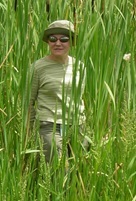 Yvonne Vallette is an Aquatic Ecologist with the U.S. Environmental Protection Agency (EPA). For the last twenty-three years she has worked at EPA Region 10’s Oregon Operations Office in Portland serving as the Region’s coordinator for enhancing State and Tribal Programs. Her work with EPA is focused on the technical and policy aspects of the Clean Water Act (CWA), including Section 404. Her practicable experience includes work in: aquatic resource monitoring and assessment, 404 enforcement, compensatory mitigation, impact analysis, CWA jurisdiction, 404 program assumption, and aquatic resources restoration.
Yvonne Vallette is an Aquatic Ecologist with the U.S. Environmental Protection Agency (EPA). For the last twenty-three years she has worked at EPA Region 10’s Oregon Operations Office in Portland serving as the Region’s coordinator for enhancing State and Tribal Programs. Her work with EPA is focused on the technical and policy aspects of the Clean Water Act (CWA), including Section 404. Her practicable experience includes work in: aquatic resource monitoring and assessment, 404 enforcement, compensatory mitigation, impact analysis, CWA jurisdiction, 404 program assumption, and aquatic resources restoration.
Please click only once on each video recording to view in this window.
![]()
Advancing Tribal Wetland Programs Through Innovations in Monitoring & Assessment
Held Tuesday, December 1, 2020 - 1:00 p.m.-2:30 p.m. EST
INTRODUCTION
- Marla Stelk, Executive Director, Association of State Wetland Managers [PRESENTATION PDF]
PRESENTERS
- vYonne Vallette, U.S. Environmental Protection Agency, Region 10 [PRESENTATION PDF]
- Ferin Davis Anderson, Lead Environmental Scientist, Shakopee Mdewakanton Sioux Community [PPRESENTATION PDF]
- Eric Krumm, Water Resources Technician, Leech Lake Band of Ojibwe Water Resources Program [PRESENTATION PDF]
ABSTRACTS
Yvonne Vallette and William Kirchner
Using National Wetland Inventory Data to Assist State/Tribe Wetland Monitoring and Assessment Efforts
The US Environmental Protection Agency (EPA) recommends that states and tribes use a consistent, thorough and timely wetland monitoring and assessment program as a critical tool for them to better manage and protect their wetland resources. These programs allow states and tribes to: 1) establish a baseline in wetlands extent, condition and function; 2) detect change; and 3) characterize trends over time. To further assist States and Tribes, EPA’s Wetland Program Development Grants (WPDG) provides needed financial resources to support actions and activities that together comprise a comprehensive wetland monitoring and assessment program, which must be able to identify the location and extent of these resources in designing their monitoring and assessment efforts.
The US Fish and Wildlife Service’s (FWS) National Wetlands Inventory (NWI) is a publicly available geospatial data set that provides detailed information on the abundance, characteristics, and distribution of streams and wetlands throughout the US. Natural resource managers can use the data to promote the understanding, conservation and restoration of these aquatic resources. In 2016, FWS released version 2.0 of their national NWI aquatic ecosystems, like streams. NWI 2.0 data is a reasonable representation of the resources at the landscape scale. Because of its coarse scale, dataset, which is a comprehensive characterization of all surface water features on the landscape, including a wide range of wetlands and other and the classification, the data is suitable for establishing a baseline for resources either statewide or at watershed scale. This comprehensive dataset allows the accurate, consistent calculation of area and ecological classification to best support geospatial summaries and modeling for management decisions and for identifying monitoring and assessment efforts that will support State or Tribal aquatic resource programs. This presentation will explore the specifics on the use or development of NWI compliant data into a State/Tribal monitoring and assessment program or project.
Ferin Davis Anderson
Integrating Drone and LiDAR Technology into Tribal Wetland Programs
The Shakopee Mdewakanton Sioux Community (SMSC), located 30 miles southwest of Minneapolis, MN, was awarded an Environmental Protection Agency (EPA) Tribal Wetland Program Development Grant in 2019. The proposal was developed with the intent to advance and refine the SMSC’s existing wetland program by focusing on an EPA core element involving monitoring and assessment. SMSC plans to incorporate LiDAR (light detection and ranging) elevation data to examine the location of current and potentially historic wetlands. They will be using a drone (UAV) mounted LiDAR system that collects derivatives based on hydrologic, surface, terrain and landform features with accuracy in the range of 10-20cm. This LiDAR data will help identify important wetland functional drivers and categorize wetlands using the hydrogeomorphic (HGM) classification system based on landscape position. SMSC seeks to demonstrate how UAV-mounted LiDAR can be used as a tool to further prioritize ecologically significant wetlands and identify potentially restorable wetlands.
Eric Krumm
An ArcGIS-Based Spatial Analysis of Jurisdictional Wetland Extent within the Leech Lake Reservation In North Central Minnesota
As a component of a comprehensive, long-term wetland surveying and mapping strategy the Leech Lake Band of Ojibwe (LLBO) Water Resources Program developed an assessment platform to evaluate a range of potential jurisdictional Waters of the United States (WOTUS) scenarios within the external boundaries of the Leech Lake Reservation in North Central Minnesota. Federal definitions and the scope of Clean Water Act regulation across the United States have been influenced by regular federal updates as well as Supreme Court rulings since its inception in 1972. While the specific definitions of “wetlands” and “tributaries” have remained relatively static over the course of Clean Water Act implementation, the criteria for determining if these water bodies are regulated by the Clean Water Act (i.e. jurisdictional) have varied considerably. An adaptable ArcGIS-based assessment model was developed that could be used to provide the LLBO Water Resources Program with a remotely determined range of potential WOTUS interpretations across the entire Reservation to aid in resource planning while also allowing the flexibility to update the model based on field-based mapping efforts and any potential future revisions to the Clean Water Act.
BIOS
 Yvonne Vallette is an Aquatic Ecologist with the U.S. Environmental Protection Agency (EPA). For the last twenty-three years she has worked at EPA Region 10’s Oregon Operations Office in Portland serving as the Region’s coordinator for enhancing State and Tribal Programs. Her work with EPA is focused on the technical and policy aspects of the Clean Water Act (CWA), including Section 404. Her practicable experience includes work in: aquatic resource monitoring and assessment, 404 enforcement, compensatory mitigation, impact analysis, CWA jurisdiction, 404 program assumption, and aquatic resources restoration.
Yvonne Vallette is an Aquatic Ecologist with the U.S. Environmental Protection Agency (EPA). For the last twenty-three years she has worked at EPA Region 10’s Oregon Operations Office in Portland serving as the Region’s coordinator for enhancing State and Tribal Programs. Her work with EPA is focused on the technical and policy aspects of the Clean Water Act (CWA), including Section 404. Her practicable experience includes work in: aquatic resource monitoring and assessment, 404 enforcement, compensatory mitigation, impact analysis, CWA jurisdiction, 404 program assumption, and aquatic resources restoration.
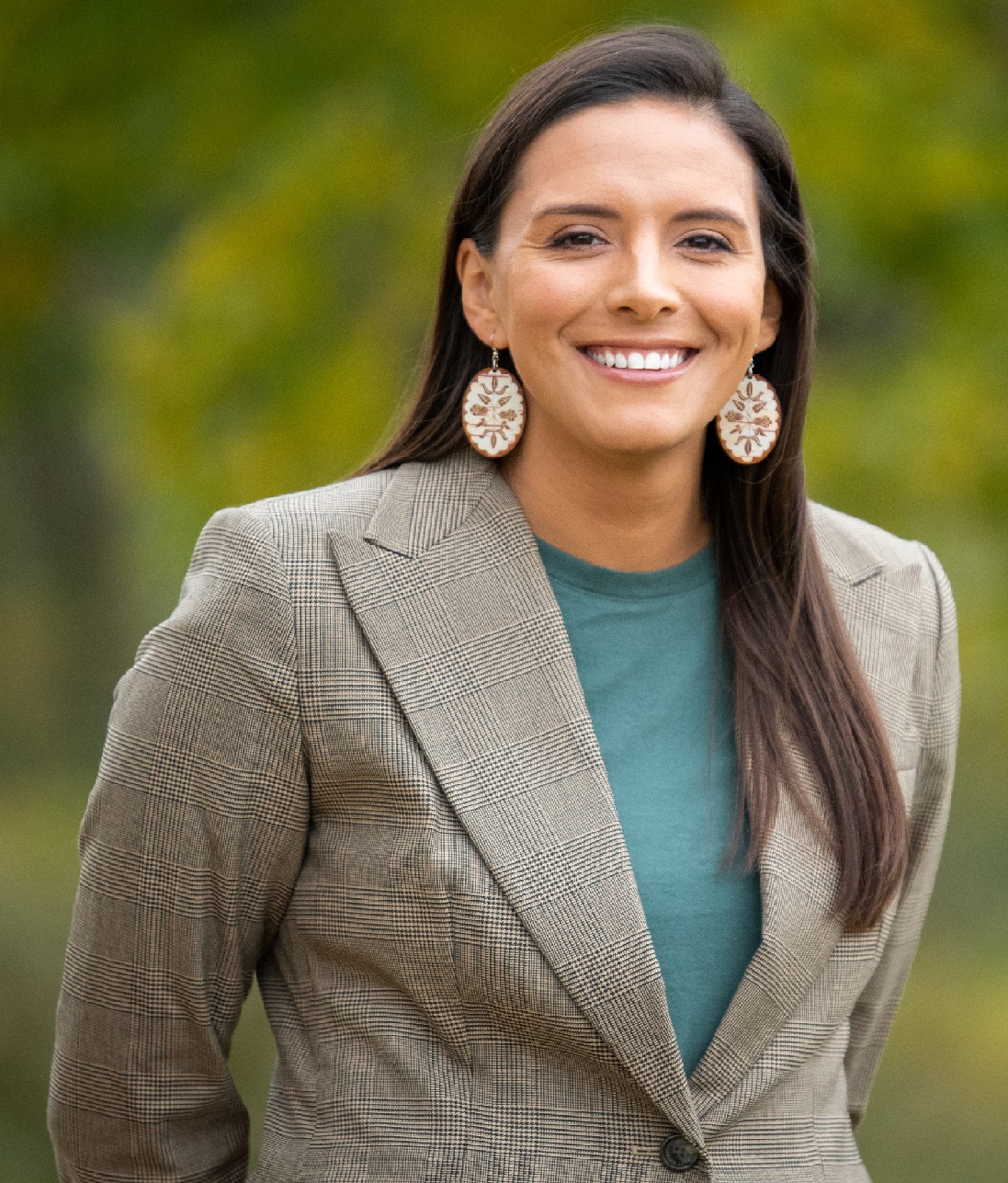 Ferin Davis Anderson is the Lead Environmental Scientist for the Land and Natural Resources Department. She has held this position since 2019. Ferin is responsible for managing, restoring and conserving prairies, wetlands, woodlands, and forests for the SMSC. She determines and implements best conservation management practices. Additionally, Ferin collects, analyzes, and reports on data collected in the field pertaining to wetland, prairie and forest vegetation. Ferin also oversees a team of specialists and technicians in the Land and Natural Resources Department. Ferin completed her Master of Natural Resources Stewardship at Colorado State University and her Bachelor of Science in Natural Resources Management from North Dakota State University. She also earned her Associate of Science and Arts degrees from the Turtle Mountain Community College in North Dakota.
Ferin Davis Anderson is the Lead Environmental Scientist for the Land and Natural Resources Department. She has held this position since 2019. Ferin is responsible for managing, restoring and conserving prairies, wetlands, woodlands, and forests for the SMSC. She determines and implements best conservation management practices. Additionally, Ferin collects, analyzes, and reports on data collected in the field pertaining to wetland, prairie and forest vegetation. Ferin also oversees a team of specialists and technicians in the Land and Natural Resources Department. Ferin completed her Master of Natural Resources Stewardship at Colorado State University and her Bachelor of Science in Natural Resources Management from North Dakota State University. She also earned her Associate of Science and Arts degrees from the Turtle Mountain Community College in North Dakota.
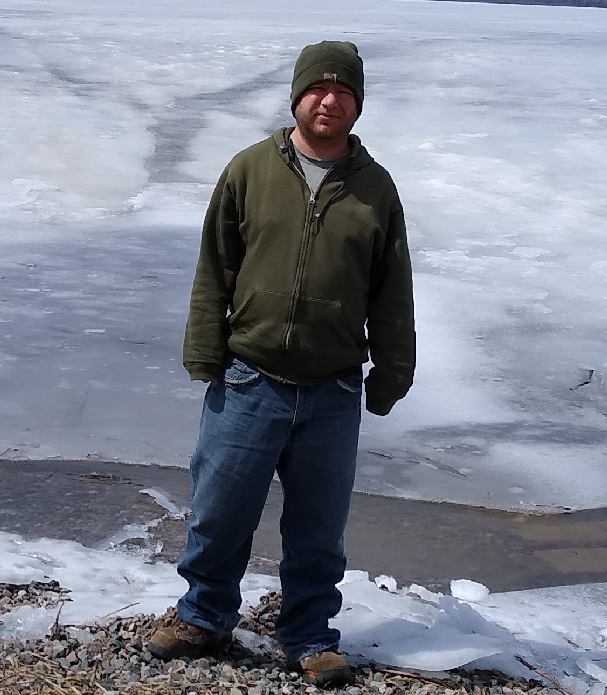 Eric Krumm is a Water Resources Technician for the Leech Lake Band of Ojibwe Water Resources Program in Cass Lake, MN. Originally from the Driftless Area of Southwestern Wisconsin, he moved to Northern Minnesota in 2015. He specializes in limnology, stream ecology, water quality assessment, hydrology, and population and trophic dynamics of fisheries in Upper Midwest rivers and streams. He holds a B.S. in Environmental Science from Winona State University in Winona, MN where his capstone project dealt with trophic dynamics of fishes along a longitudinal gradient of a large river system. Additionally, he acquired a M.S. in Biology from Minnesota State University, Mankato in Mankato, MN where his thesis work involved the effect of hydrology on the growth and recruitment of fishes in mid-sized streams in the Eastern Broadleaf Forest Province of Minnesota. Currently the focus of his work is on wetland jurisdictional analysis related to the recent change in the Waters of the United States Rule and water quality standards development for the waters of the Leech Lake Reservation. He enjoys fishing, hiking, bird watching, and canoeing with his wife.
Eric Krumm is a Water Resources Technician for the Leech Lake Band of Ojibwe Water Resources Program in Cass Lake, MN. Originally from the Driftless Area of Southwestern Wisconsin, he moved to Northern Minnesota in 2015. He specializes in limnology, stream ecology, water quality assessment, hydrology, and population and trophic dynamics of fisheries in Upper Midwest rivers and streams. He holds a B.S. in Environmental Science from Winona State University in Winona, MN where his capstone project dealt with trophic dynamics of fishes along a longitudinal gradient of a large river system. Additionally, he acquired a M.S. in Biology from Minnesota State University, Mankato in Mankato, MN where his thesis work involved the effect of hydrology on the growth and recruitment of fishes in mid-sized streams in the Eastern Broadleaf Forest Province of Minnesota. Currently the focus of his work is on wetland jurisdictional analysis related to the recent change in the Waters of the United States Rule and water quality standards development for the waters of the Leech Lake Reservation. He enjoys fishing, hiking, bird watching, and canoeing with his wife.
Please click only once on each video recording to view in this window.
Balancing Tribal Economic Development, Sustainable Cultural Uses and Wetland/Aquatic Resource Protection and Restoration
- Marla Stelk, Executive Director, Association of State Wetland Managers [PRESENTATION PDF]
- Tom Elliott, Biologist for the Yakama Nation Wildlife Program [PRESENTATION PDF]
- Allison Warner, Wetland Ecologist/Wetland Program Coordinator for The Tulalip Tribes at Quil Ceda Village [PRESENTATION PDF]
- Kara Kuhlman, Water Resources Manager for the Lummi Nation [PRESENTATION PDF]
Please click only once on each video recording to view in this window.
Cultural Values Based Planning for Integrated Wetland Management on a Watershed or
Reservation Scale
- Marla Stelk, Executive Director, Association of State Wetland Managers
- Jon Hall, Tulalip Tribes of Washington [PRESENTATION PDF]
- Tom Elliott, Yakama Nation [PRESENTATION PDF]
- Andy Robertson, GeoSpatial Services at Saint Mary's University of Minnesota [PRESENTATION PDF]
Please click only once on each video recording to view in this window.

